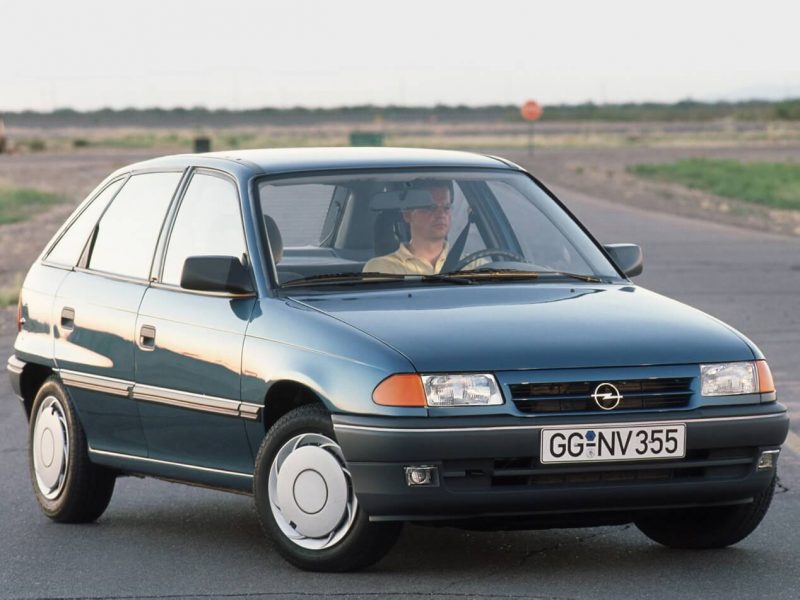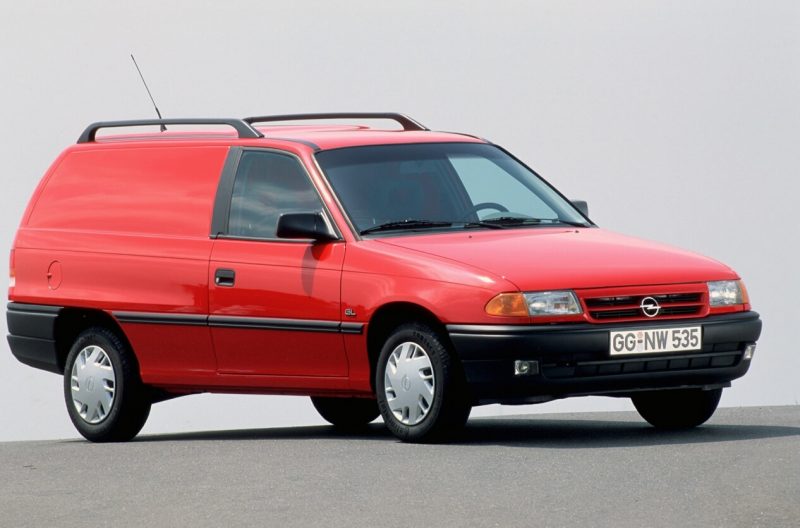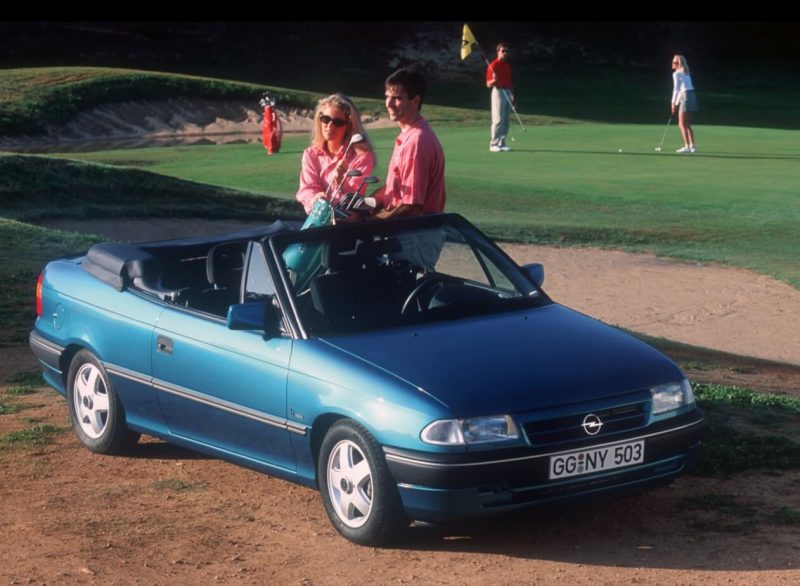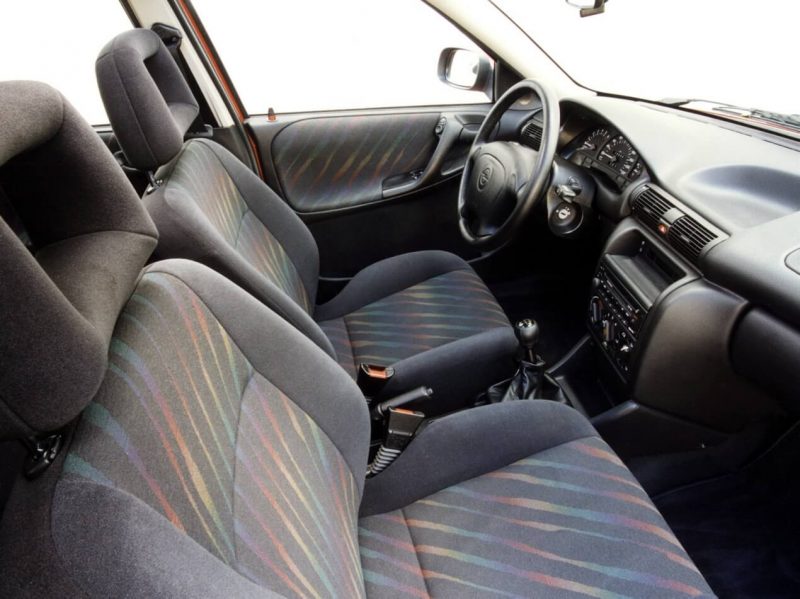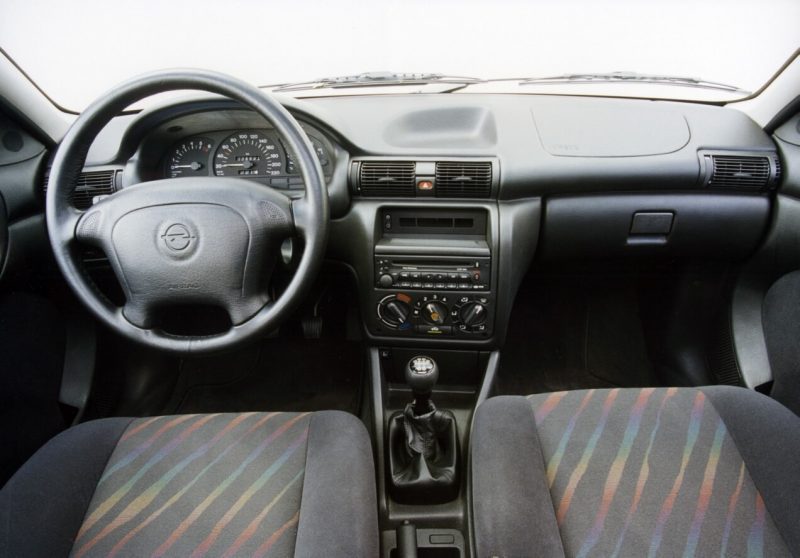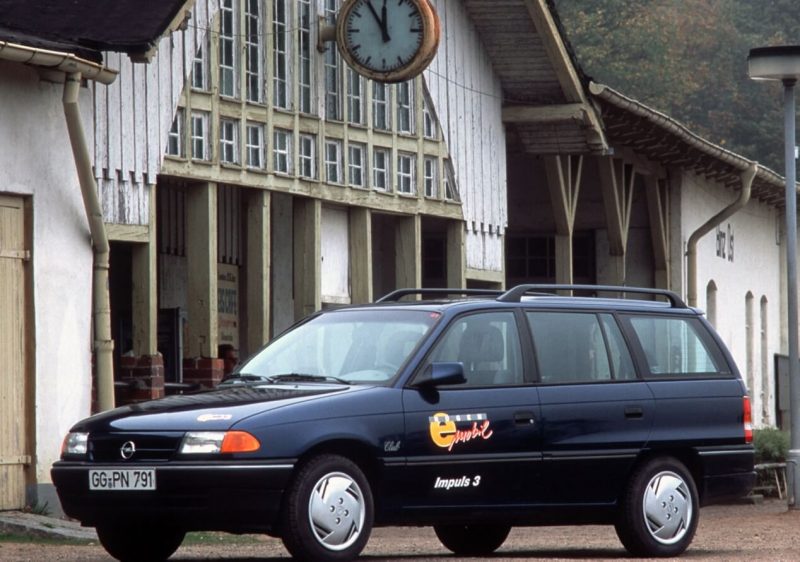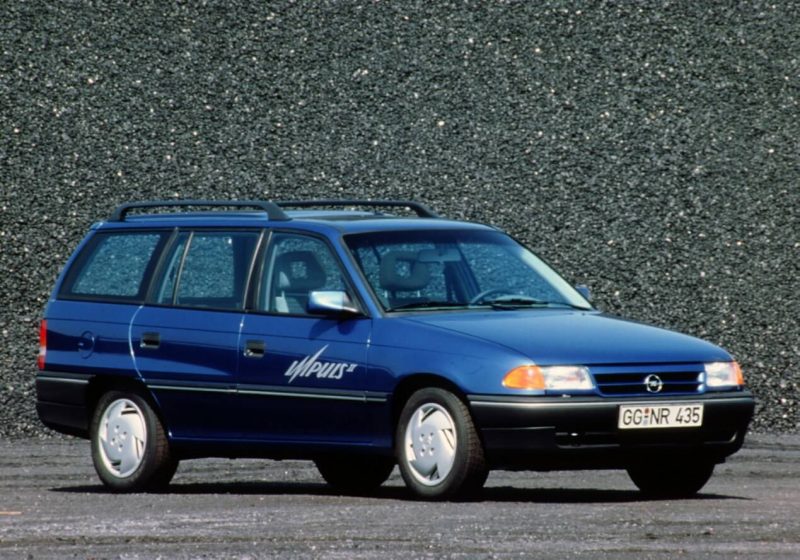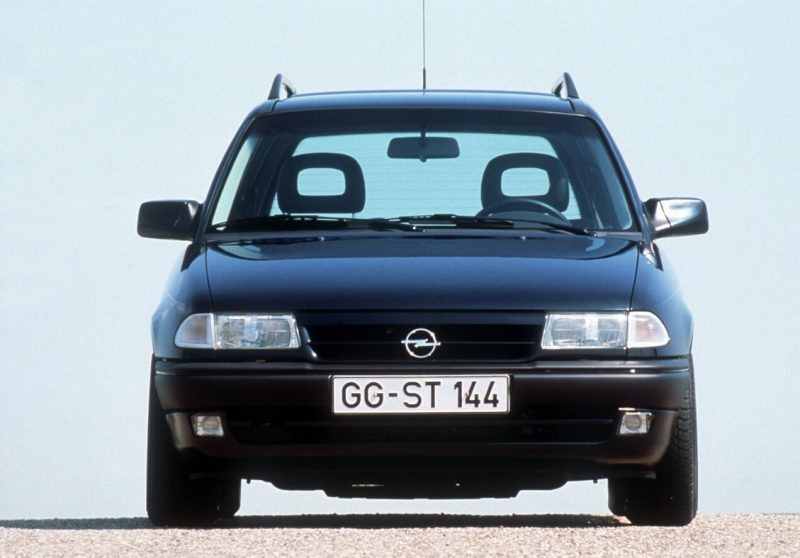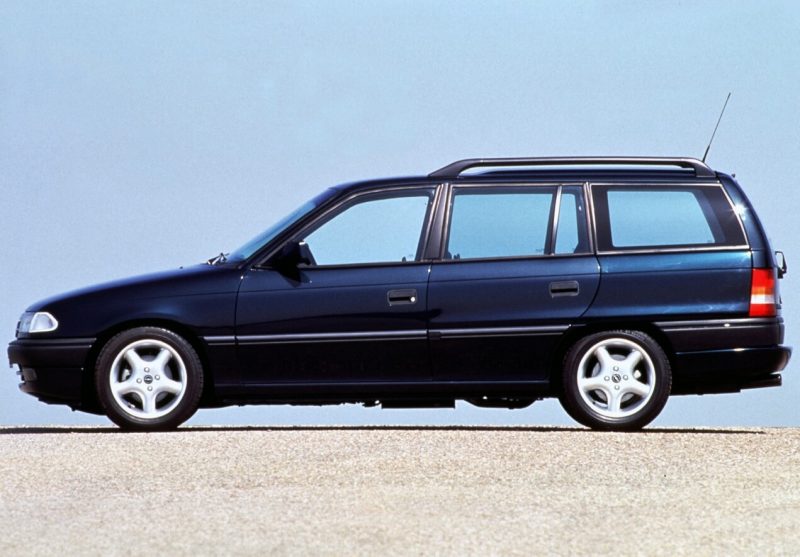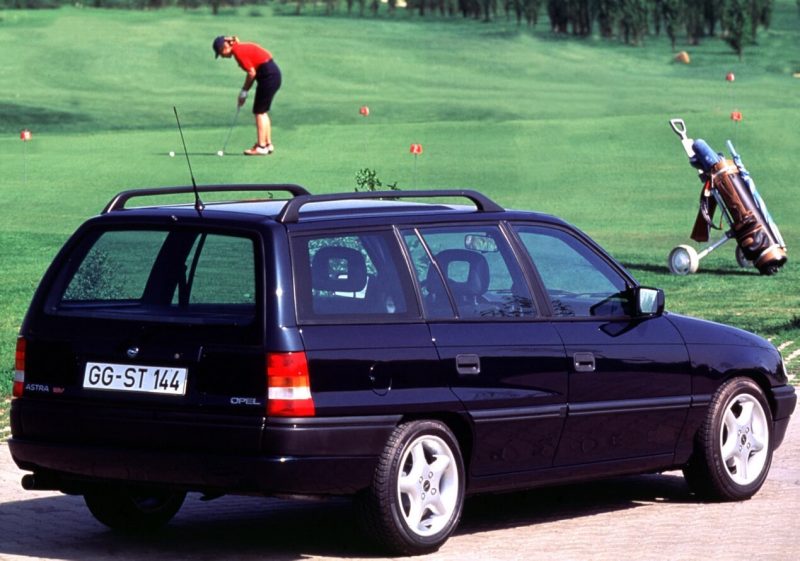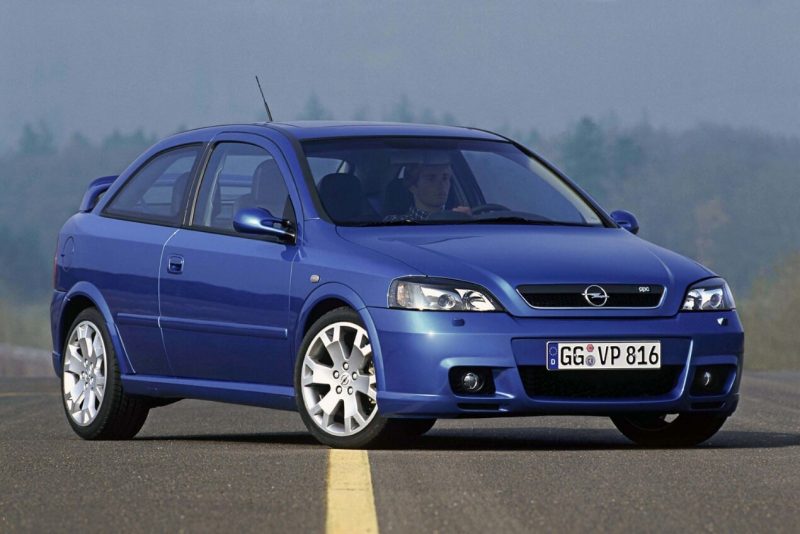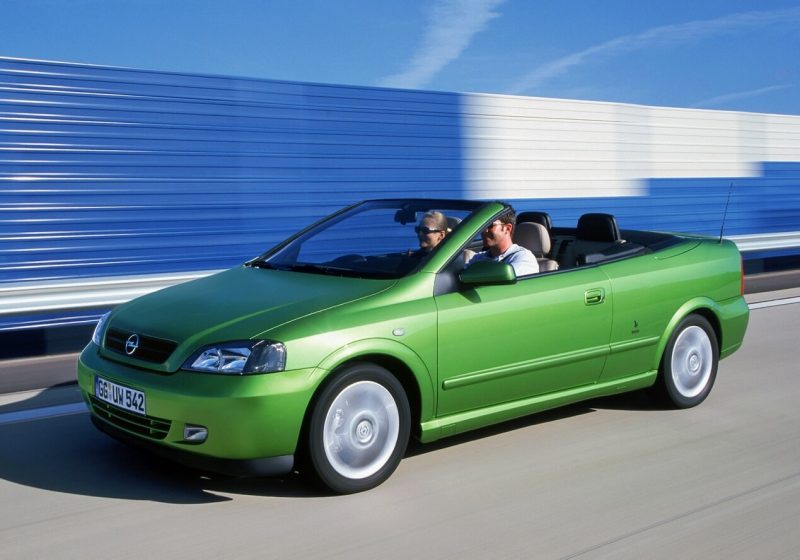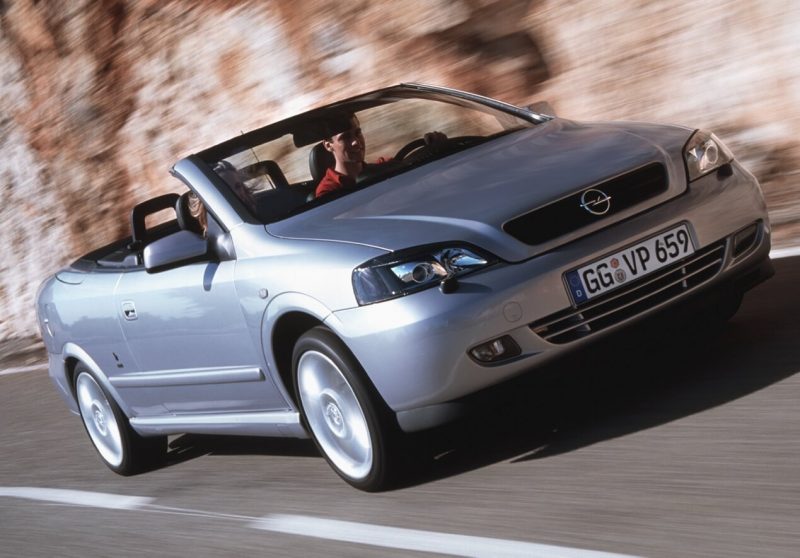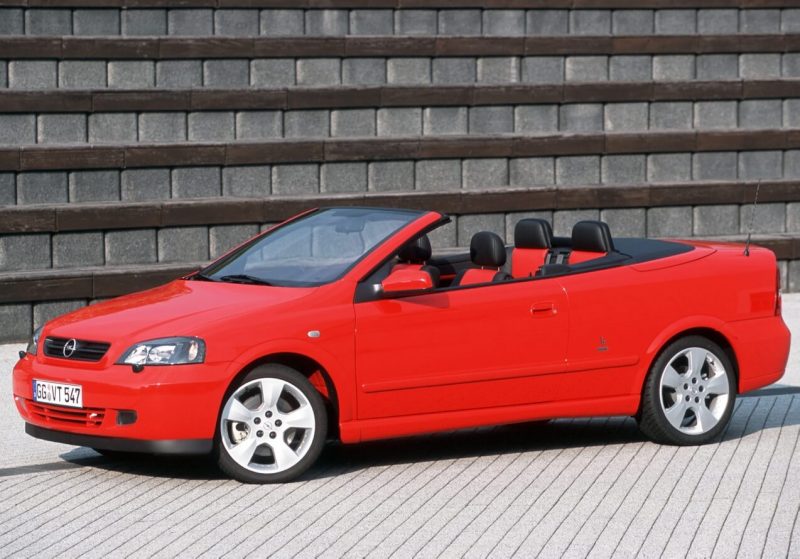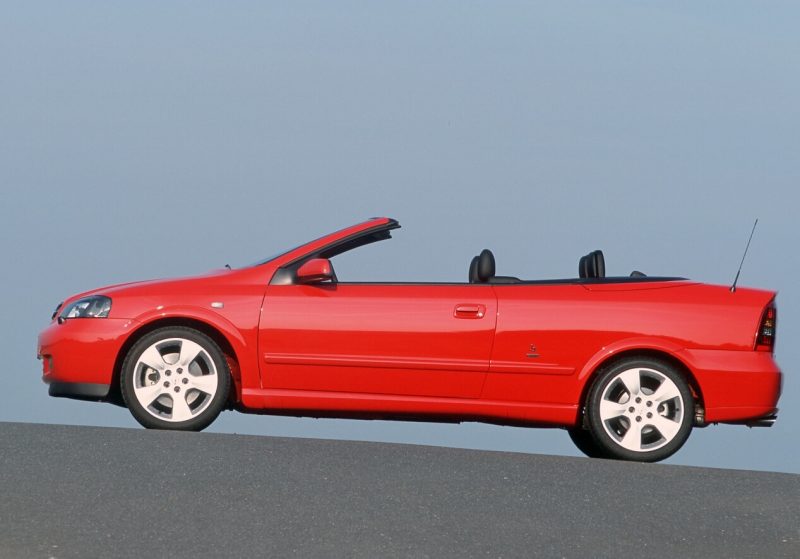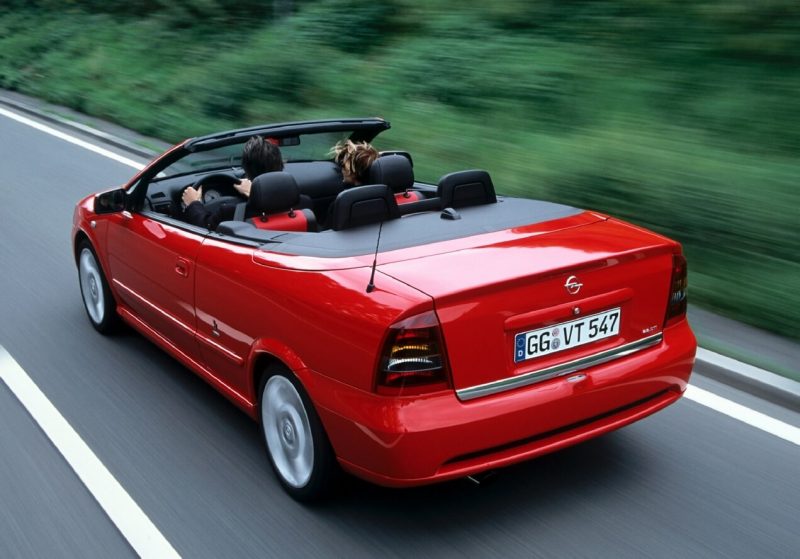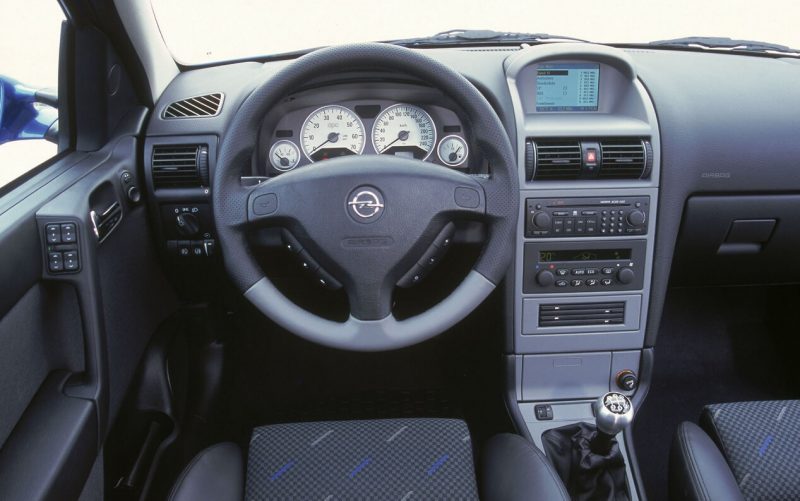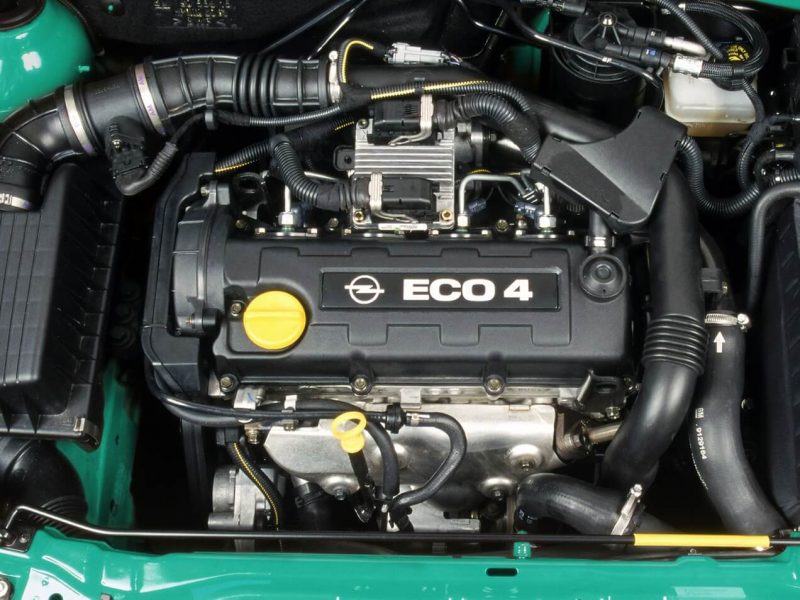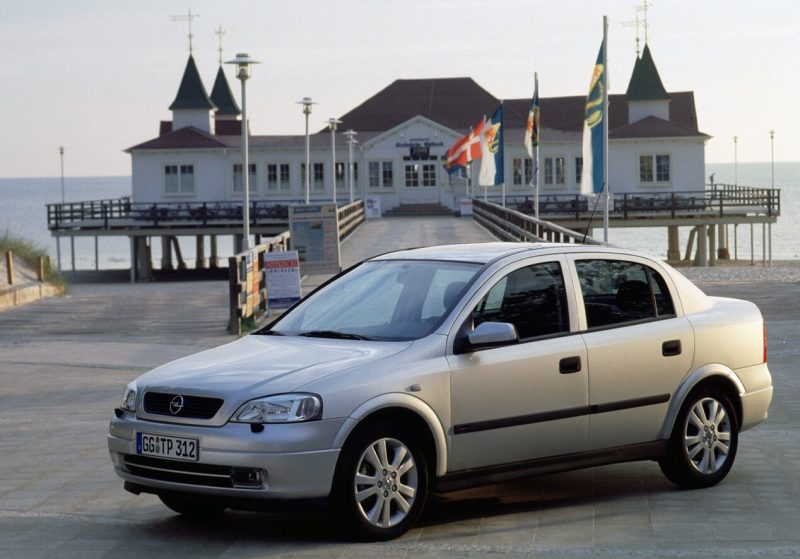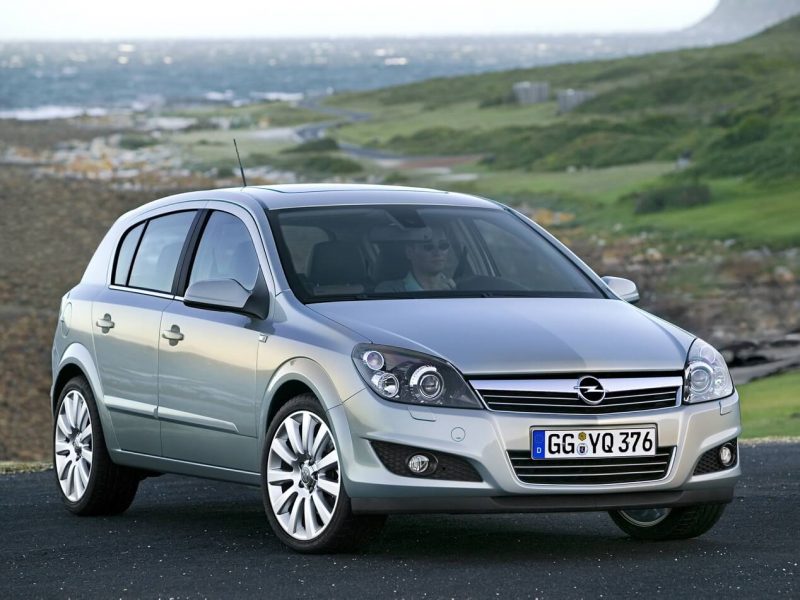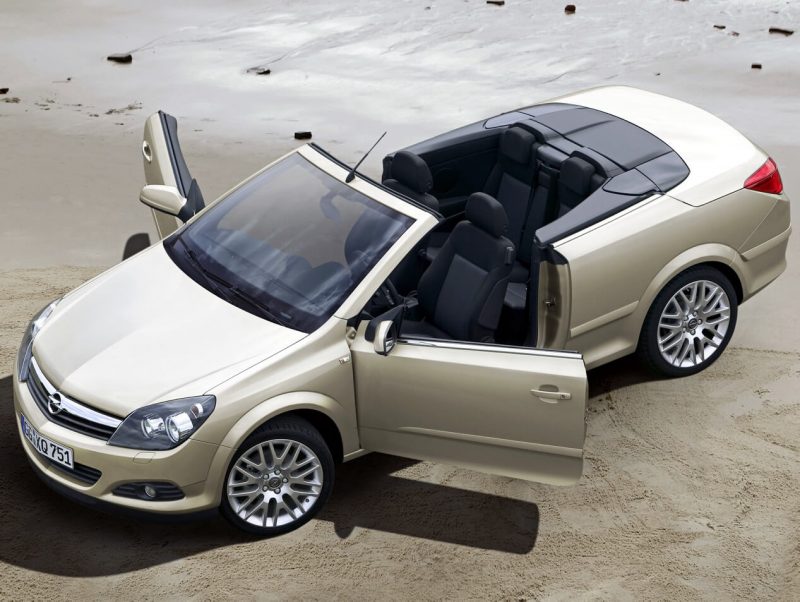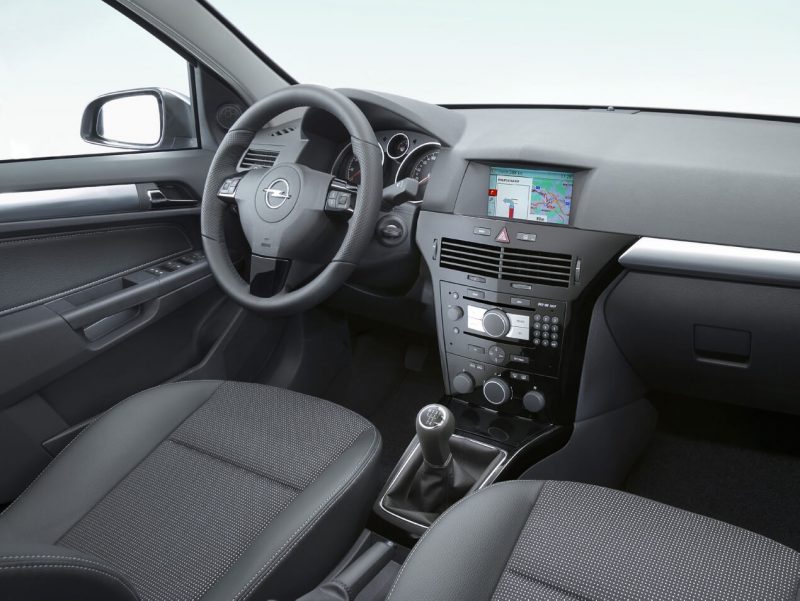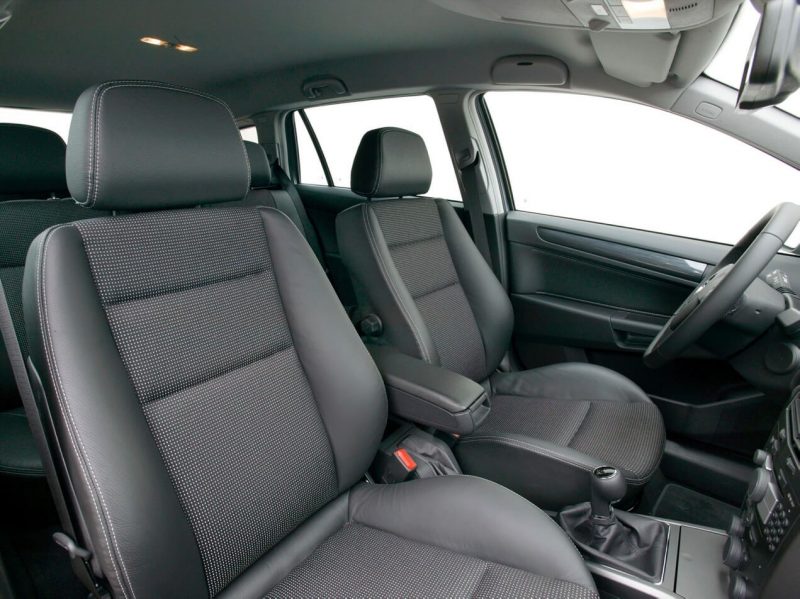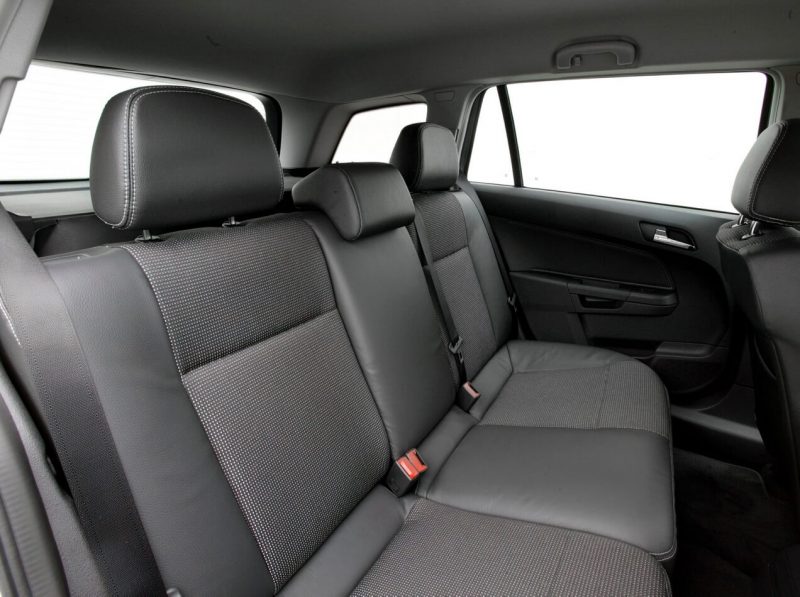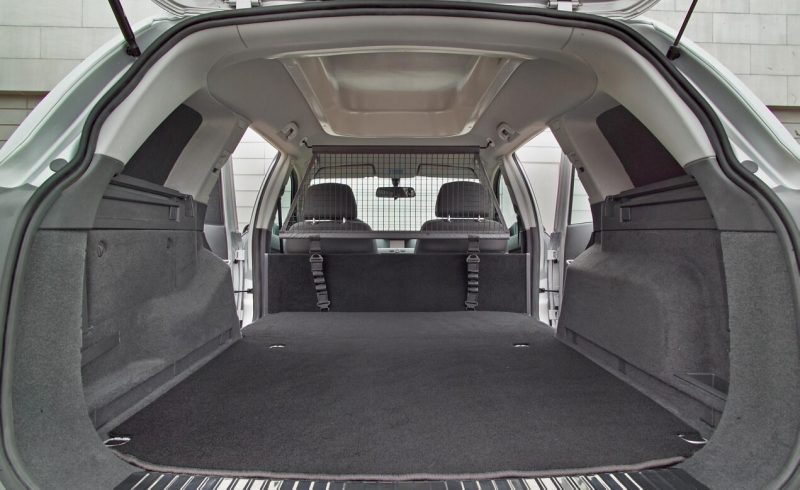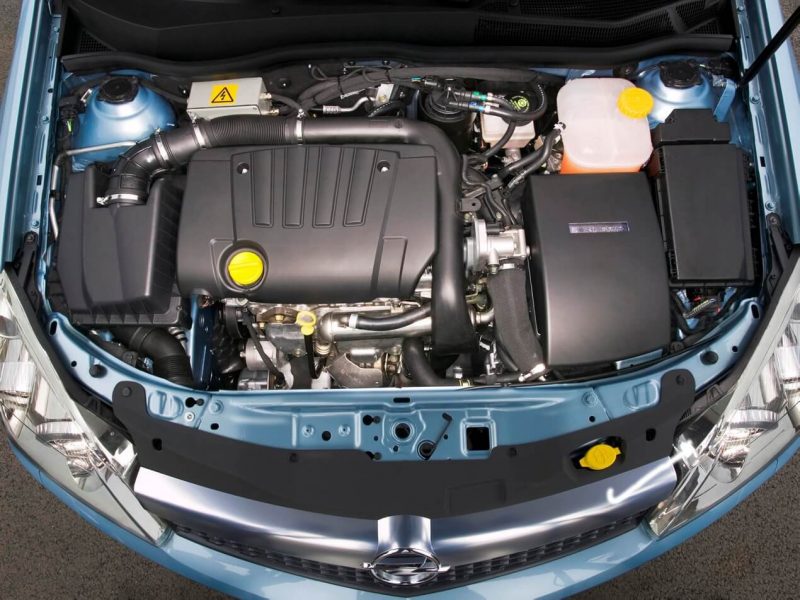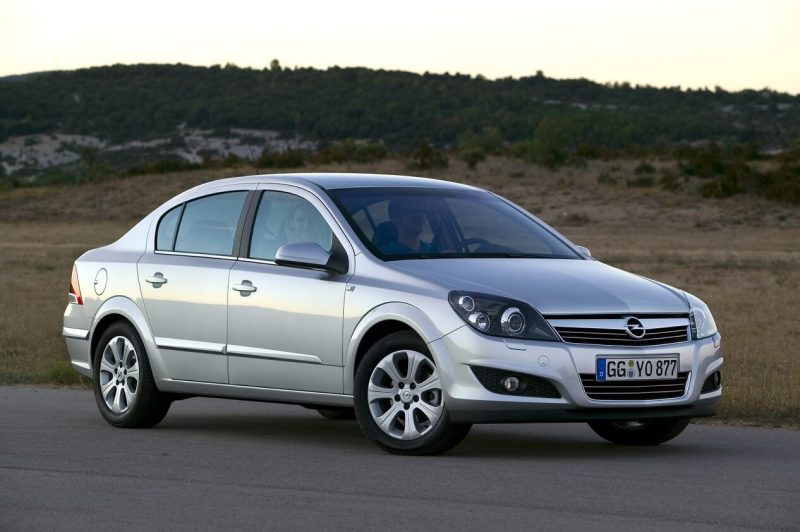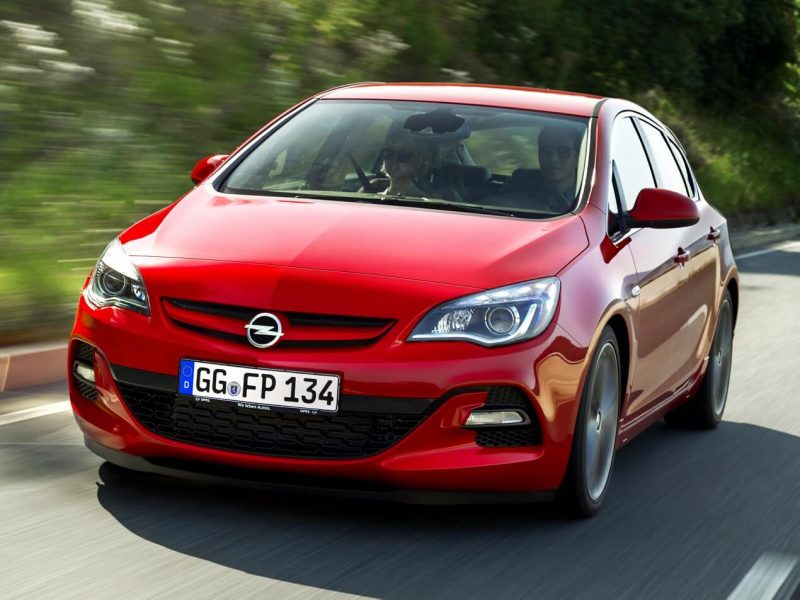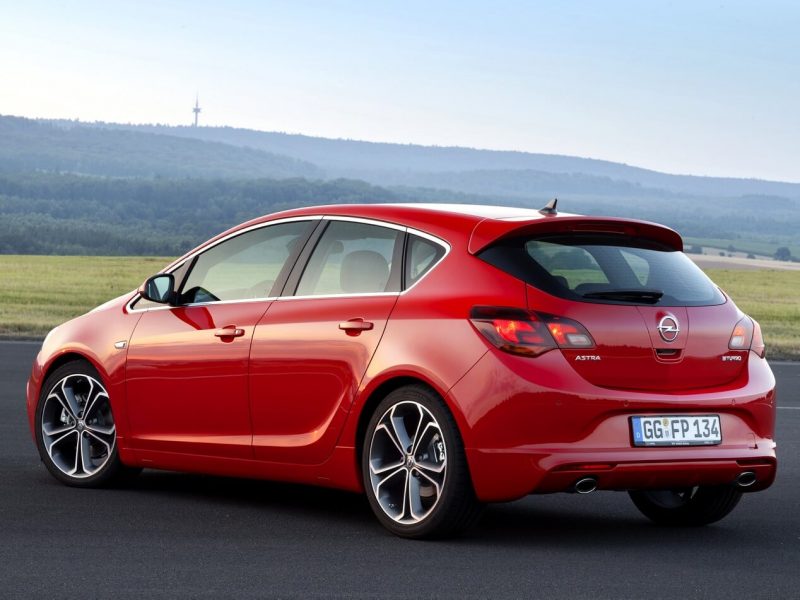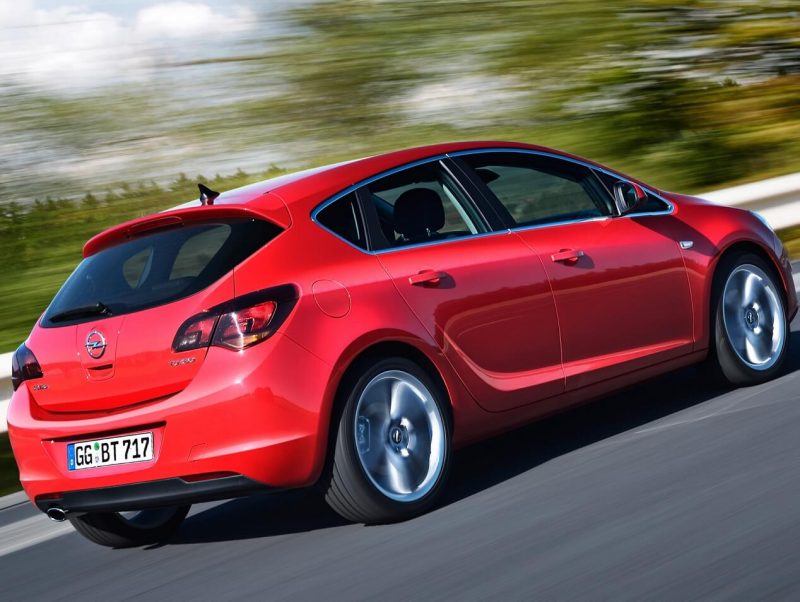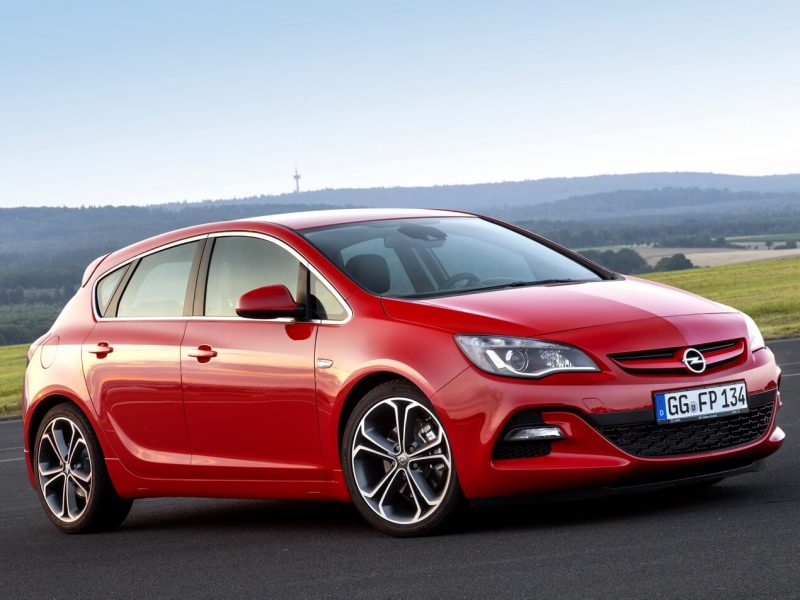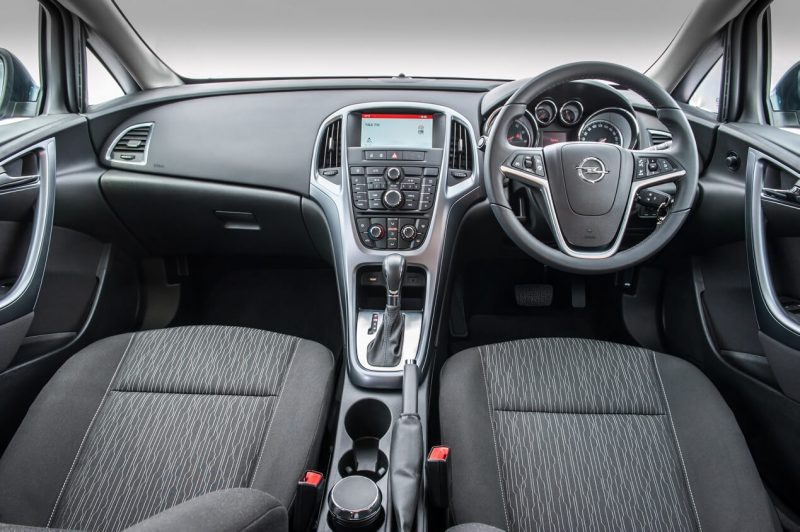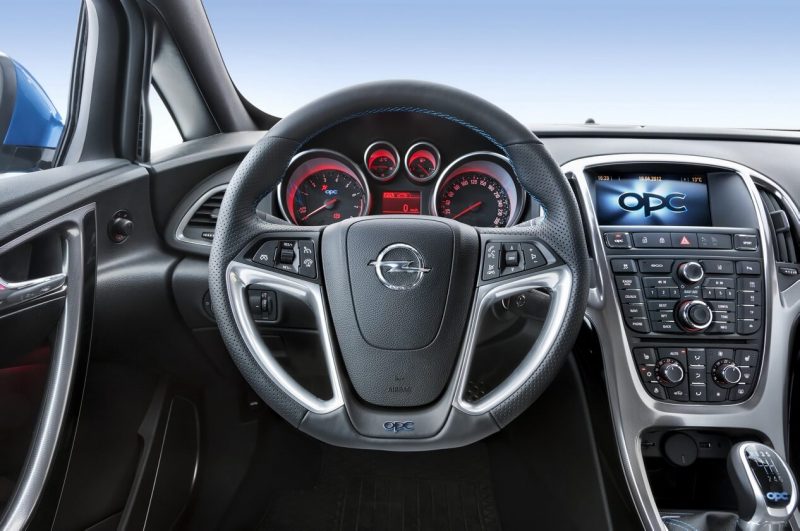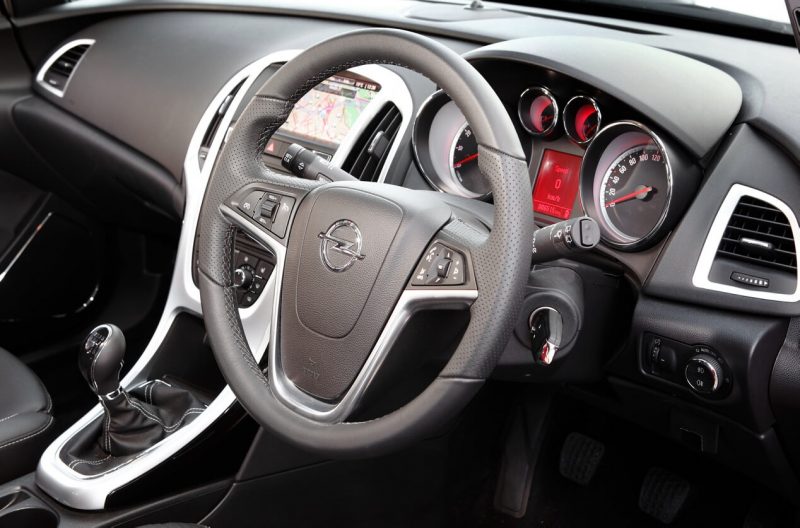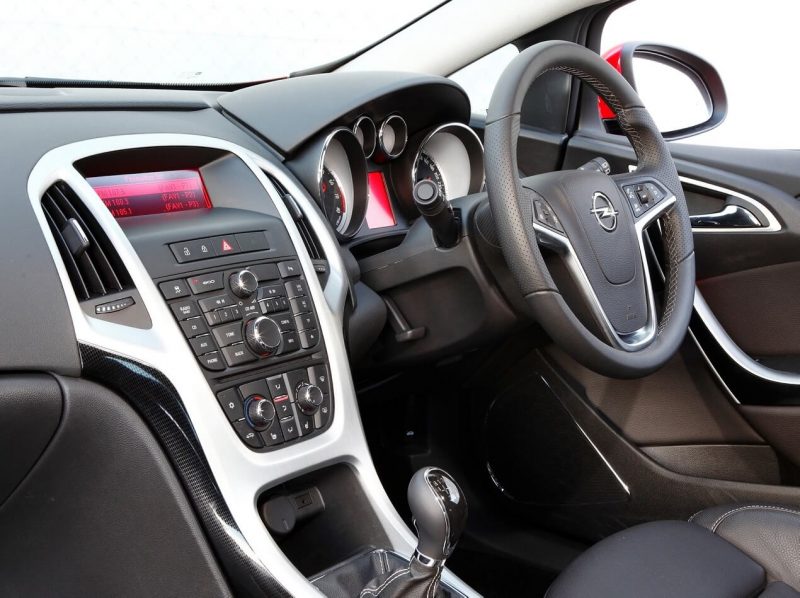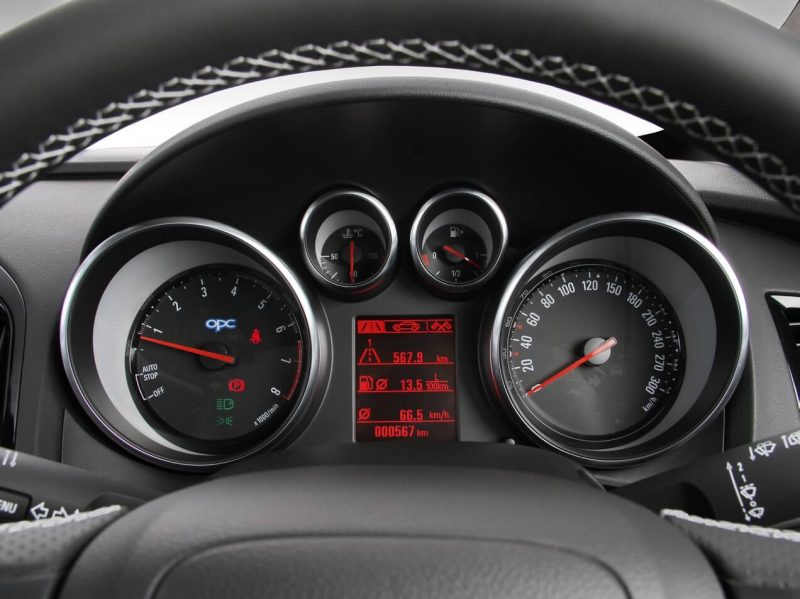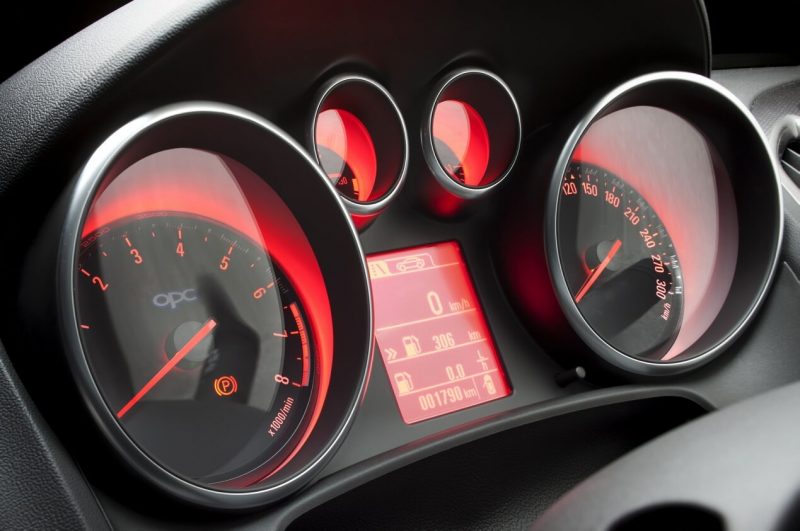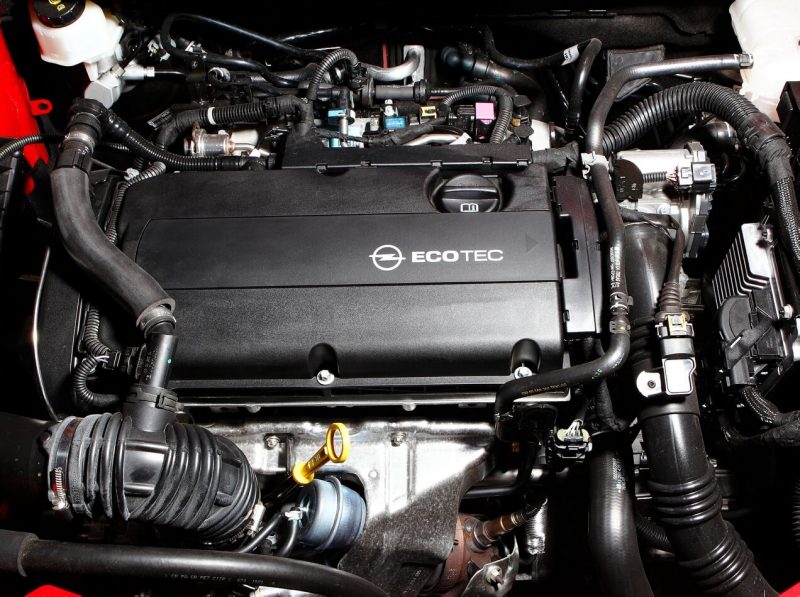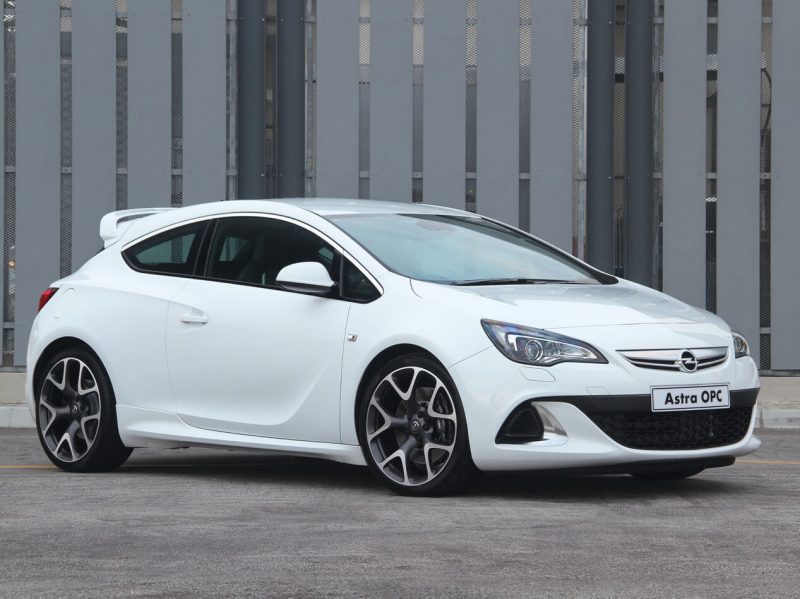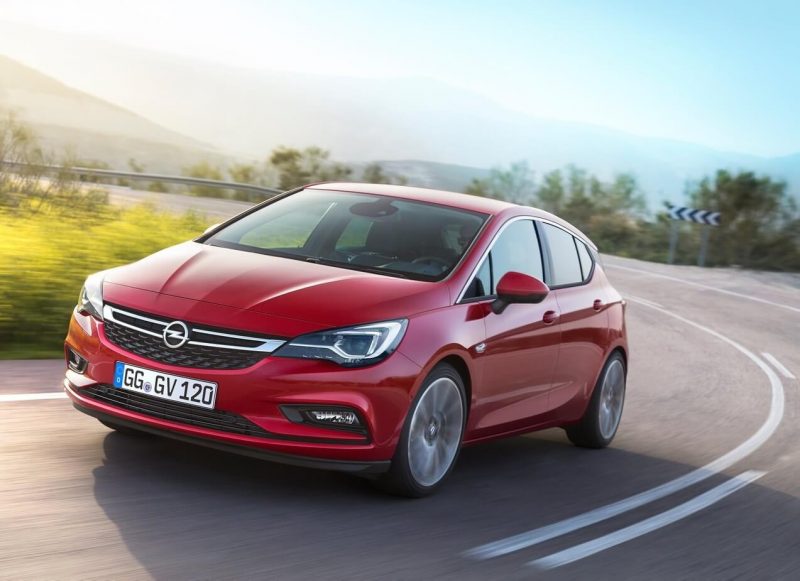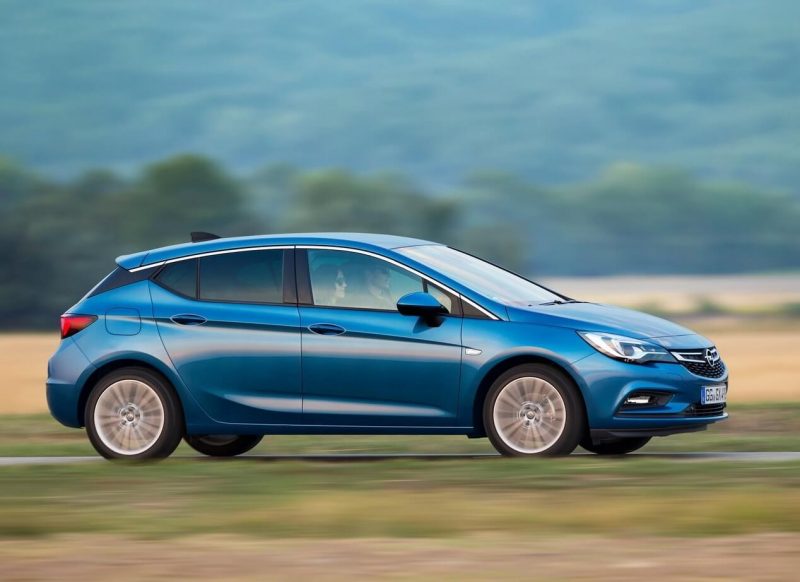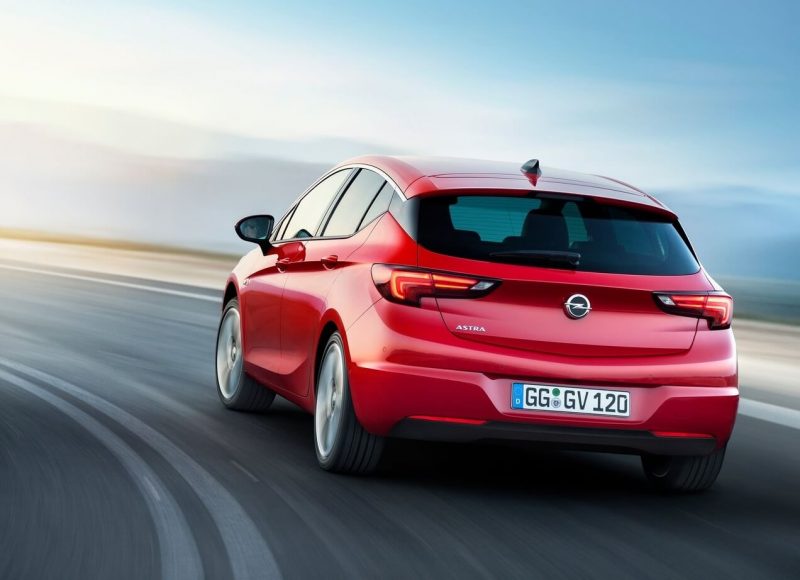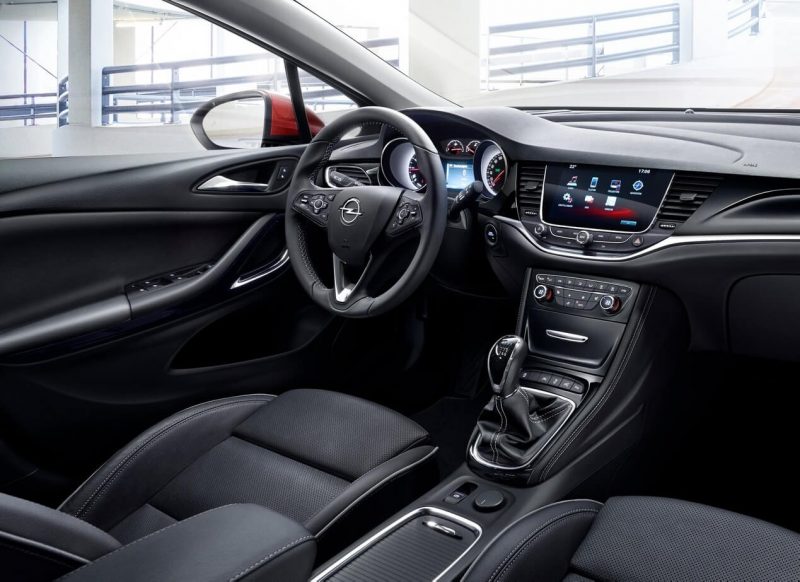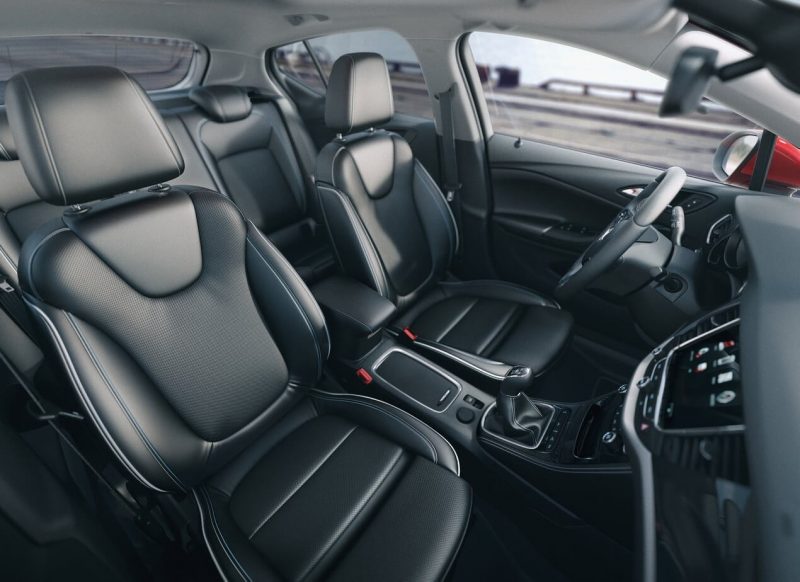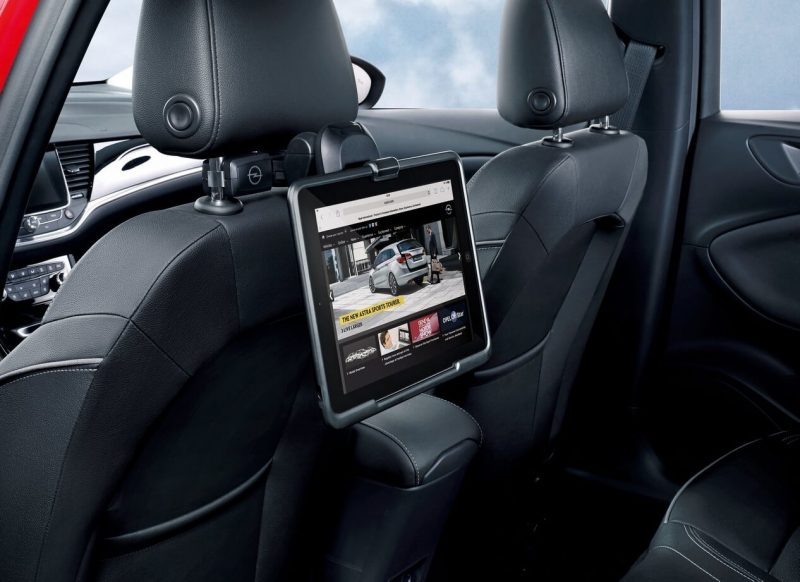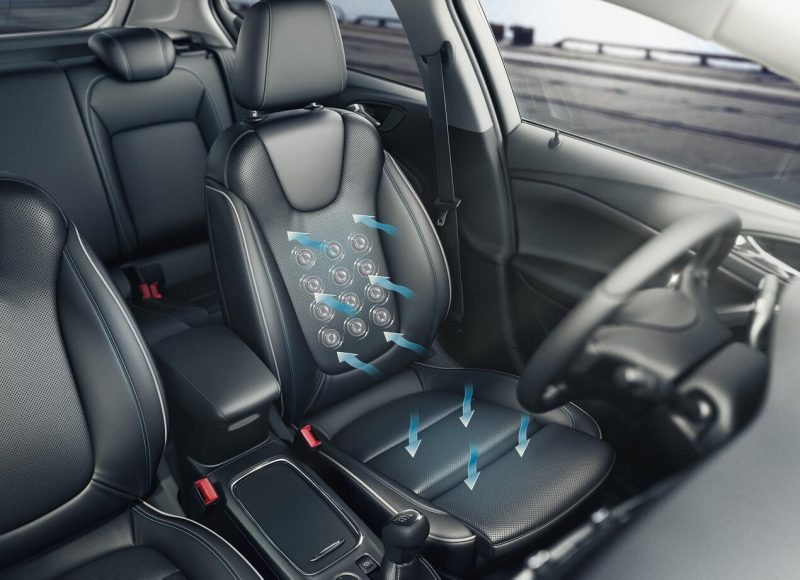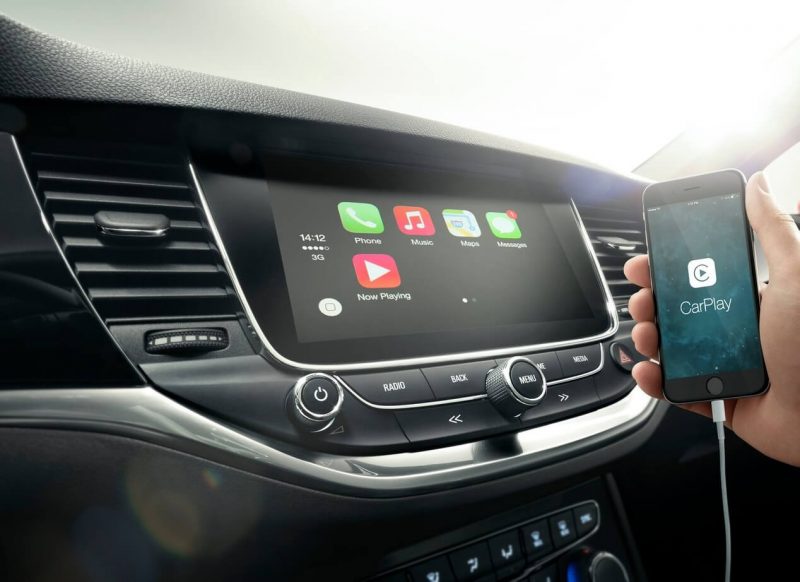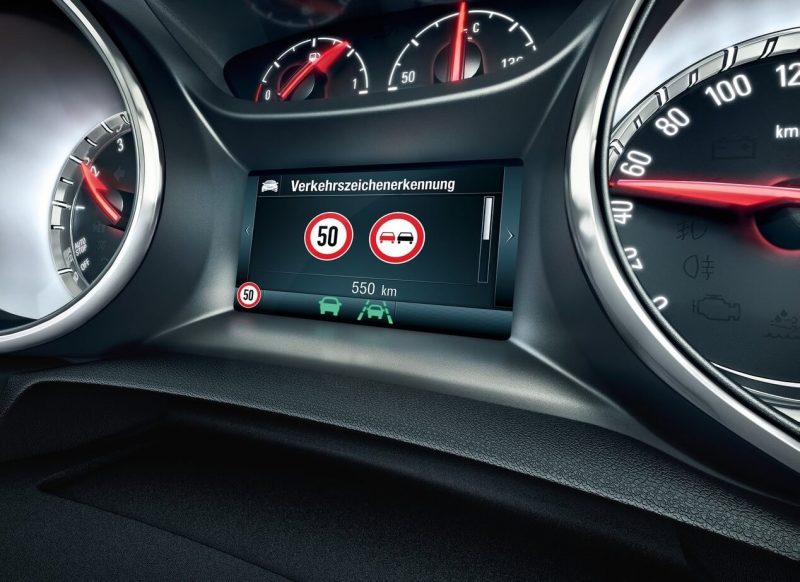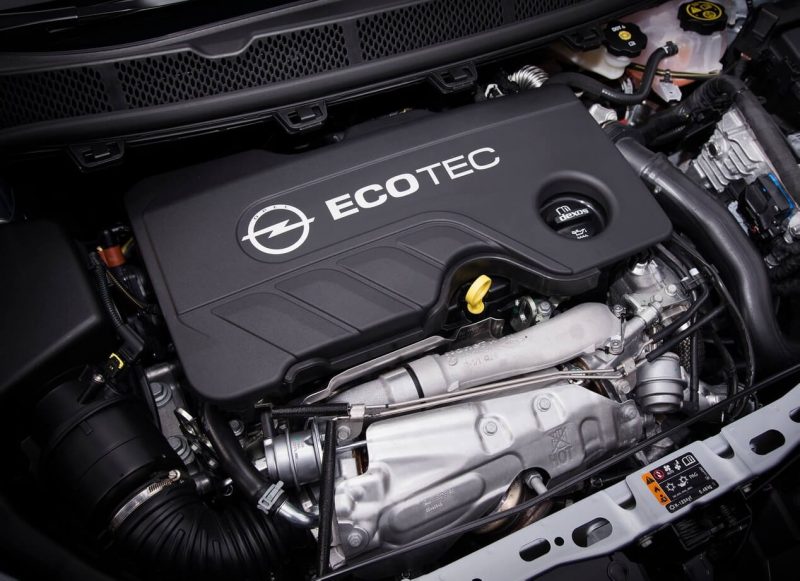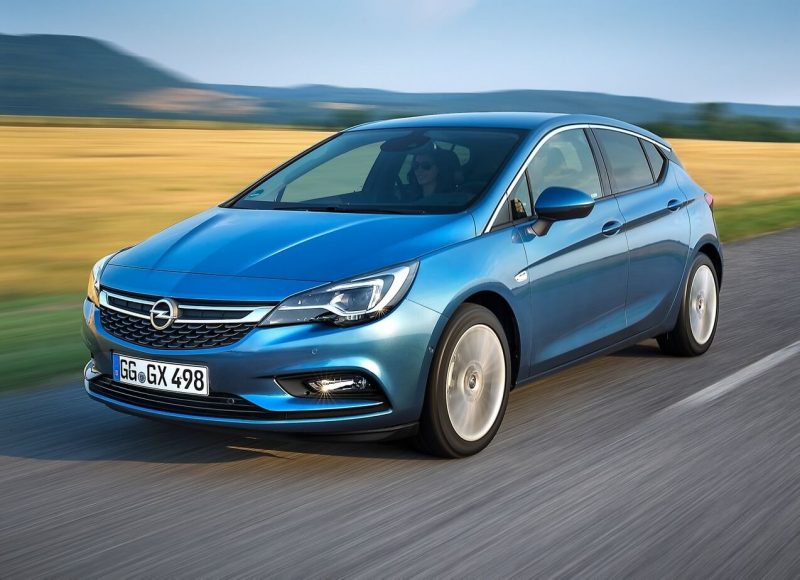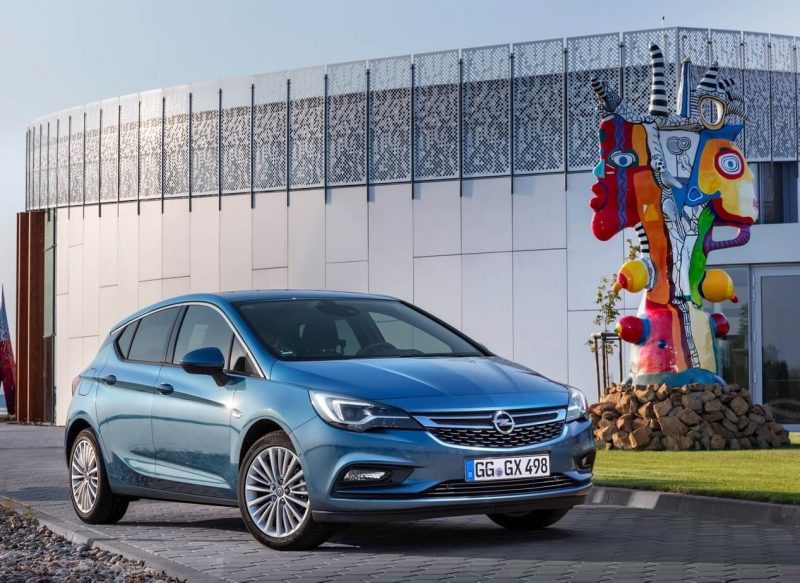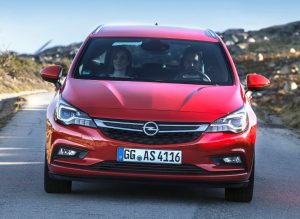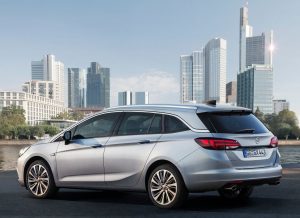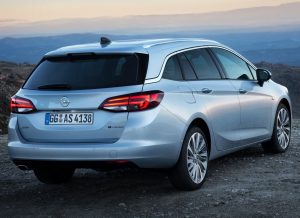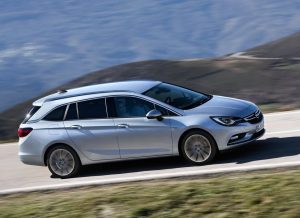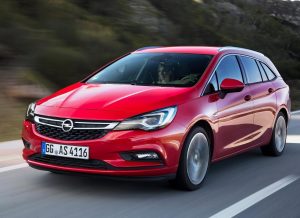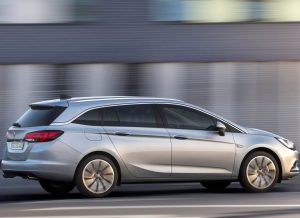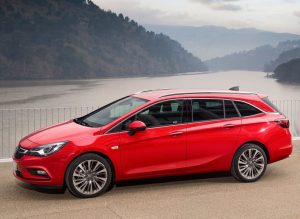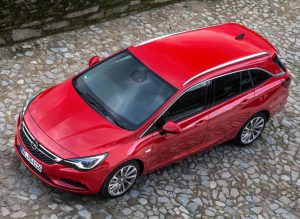Opel Astra
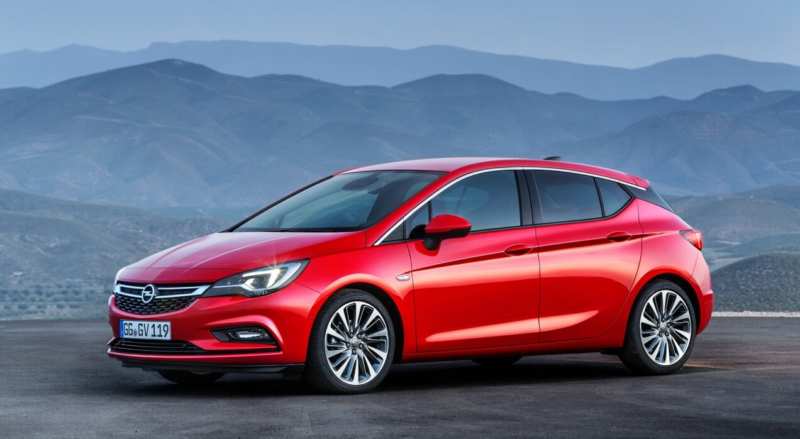
Opel Astra is a small family car (niche “C” class in the European category), which is claimed in two 5-door versions (hatchback and wagon), as well as a 4-door sedan. The model has a stylish design, competitive technical “stuffing” and an excellent level of practicality. The car is aimed at customers who want to have a modern car, but at a reasonable price. Not so long ago the new fifth generation of Opel Astra (K) was released.
This happened in autumn 2015 during the international exhibition in Frankfurt. Interestingly, Opel decided to disclose its new product early in June. The vehicle retained the proportions of the previous model, but became brighter, lighter and more technologically advanced in all respects. Following the official presentation, the hatchback should reach the counters of European dealers, but for our customers the car is unlikely to reach. The recent departure of the brand from the Russian market is all to blame. The whole model range is Opel.
- History of the car
- First generation Astra F (1991-1997)
- Second generation Astra G (1998-2004)
- Three Generation Astra H (2004-2009)
- Fourth generation Astra J (2009-2014)
- Exterior Astra J
- Interior Astra J
- Specifications
- Powertrain
- Safety
- Price and equipment
- Fifth generation Astra K (2017-present)
- Exterior
- Interior
- Specifications Astra K
- Powertrain Astra K
- Transmission
- Carriage
- Safety Astra K
- Price and equipment Astra K
- Comparison with competitors
- Owner’s comments
- Pluses and minuses
- We sum up
- Opel Astra (K) photo
- Test drive
- Video overview
History of the car
First generation Astra F (1991-1997)
The debut family of Opel Astra compact class machines has been produced since July 1991. In autumn 1994, the vehicle underwent minor improvements. The vehicles were produced in Poland under the name Astra Classic. Opel Astra (F) is the successor of Opel Cadet (E) and is the sixth version in the series Kadett/Astra.
After the renovation in 1994, the company started producing an upgraded version of the Astra (F) machine, which received improved corrosion protection. It is nice that the company has taken into account the desire of customers and allowed as an option to install a four-speed automatic transmission of the Japanese company Aisin AW.
Like other Opel cars produced in the past years, the bodywork of Astra (F) did not have a zinc protective coating, however, the quality of paintwork was good enough. This moment allowed the company to provide a guarantee for its products for 6 years. It touched the body, and to be more precise, its invulnerability to rust.
In addition to the 3- and 5-door bodies, Opel Astra had a version of a sedan and a wagon. A small amount of 3-door station wagon was produced (similar variant had no glazing). Very seldom can be also found the Opel Astra model in the body of the convertible, which was produced since 1993 at the company’s facilities Bertone.
As mentioned above, 3 years after the presentation of the car, the modernization was carried out. Thanks to the renovation, new turntables and radiator grilles were installed. Previously the turn signals were orange, but restyling changed them to white.
The appearance of the Opel Astra (F) 1st family is called calm and a bit classic. It will not be superfluous to notice that this model does not differ from the overestimated price list, therefore many people prefer the European, and not VAZu or GAZu.
Very pleased that after the update in 1994, all Opel Astra (F) even in the basic version had a hydraulic power steering. Besides, the minimum complete set possessed forward electric window lifts.
The basic music system of the German machine has 4 speakers. Even then, the German company was seriously concerned about the level of safety, equipping its models with belt tensioners with pyropares, which, together with the front Airbag, available in a minimal package, significantly increased the level of safety in the first generation of Opel Astra (F).
If we speak for the ventilation system, it had air recirculation, blocking the way to the outside air inside. Already in the following 1995, the debut version had a new front panel. The German salon had a clear and understandable dashboard, which displayed the basic data of the car.
The steering wheel was comfortable and big. To the left of it was a “twist” of the lighting with the function of correction, as well as the keys to turn on the front and rear fog lights. The seats installed in the front are quite comfortable and have a good side support.
The central console received a “pocket” of small dimensions, at the end of which information about the time, date and temperature overboard was displayed. The back of the sofa, according to the first generation Opel Astra owners, was shortish. The sedan version was equipped with a luggage compartment with a capacity of 500 liters. Three and five-door hatchback could boast only 360 liters of useful space.
From the very beginning, only gasoline engines with a capacity of 1.4 to 2.0 litres were installed on German vehicles. All engines had an electronic fuel system, but some markets could see the first carburettor engines, such as 14NV 1.4 liters, which developed 75 horsepower. The vehicles were equipped with a diesel engine 3 months after the car was released.
Initially, only one diesel engine was available – 17YD 1.7 liters, which developed 57 “horses”. The gearbox can be five-speed manual or four-speed automatic (Aisin).
It is noteworthy that Opel Astra (F) of the I generation had a wide range of active and passive security systems. During the design of the machine, specialists were able to calculate the rigidity elements using a computer. The body was distinguished by its torsional strength. Height-adjustable seat belts were installed.
The seats, together with the seatbelt buckles, were designed to prevent the person sitting under the seatbelt from slipping. Astra (F) had an optional airbag for the owner. By the end of 1994, two airbags were being fitted as standard. Electronics, in the form of an anti-lock system, could be installed as an option until the very end of the car production.
As for the suspension, it was moderately soft and comfortable, and with the help of a transverse stability stabilizer at the front and back, the machines held the road well. Ahead was an independent suspension of McPherson type, and the rear was semi-independent, where springs and shock absorbers were separately installed. The steering wheel had a rack and pinion mechanism and was characterized by acceptable information. As a braking system, disk devices were installed at the front and drum mechanism at the back.
Second generation Astra G (1998-2004)
In 1997, during the next Frankfurt Motor Show, the second Opel Astra family was presented for the first time, which received an index (G). Interestingly, they decided not to take anything from the previous generation – it was a newly designed car.
Production of Opel Astra of the 2nd generation was stopped in 2004, but the car continued to be sold in Russia until the first half of 2005. This variant is called more “compartment” in terms of design. The novelty began its life as a 3- and 5-door hatchback of the C-segment, was also a station wagon, convertible, coupe and a famous sedan.
Fully galvanized bodywork is one of the factors that made the 2 Astra family a revolutionary machine. The chassis, ergonomics, design, bodywork, all decided to radically review and design almost anew. They decided not to change only the ideology of the model – the possibility of completing it for any stylistic solution, character, temperament and financial condition of a person.
Bertone, a company from Italy, was engaged in production of Astra in the back of the coupe and convertible. The German car’s drag coefficient in the “Sedan’s” version was 0.29. The convertible with the lowered roof received only a slightly increased figure – 0.32.
The conical style of the Opel Astra of the 2nd generation has bright brand features, in which you can clearly recognize the vehicles from Rüsselheim. It turned out to be a really stylish car. The soft curves of the surfaces, which contrast with the edges and lines, do not lose the integrity of the former Astra models.
The body has athletic notes, too. The windshield was moved forward by 120 millimeters, which made it possible to emphasize the wedge-shaped type of body, visually reducing the size of the hood. The saloon turned out to be simple and laconic. Among the innovations, it is possible to name presence of the liquid crystal display of the onboard computer and an airbag for the passenger.
If we compare the novelty with its “cramped” predecessor, Astra Opel of the 2nd generation turned out to be more spacious. It often happens that due to significant temperature changes inside the car and outside, the windshield may crack. Even the management of the company itself recognized the problem of insufficient strength of the glass and quite often replaced the front glass under the warranty.
The designers decided to borrow the pedal knot from Vectra Opel (B), and this is reflected in the fact that in case of a serious collision the pedals are disconnected, and this in turn prevents them from “going” to the cabin. The basic design of the Opel Astra (G) has a driver’s airbag, however, you can often find 4 or even 6 Airbags.
The luggage compartment of the German-made 3- and 5-door hatchback has received 370 liters of useful space. The sedan has a capacity of 460 liters and a record volume of 480 liters. However, this is not all, if necessary, this figure can be significantly increased up to 1,500 liters, if you add up the rear backrests.
The list of power units has economic gasoline engines, in number of 6 copies and a couple of engines running on diesel fuel. The gasoline list starts from 1.2-liter (65/48 hp) to 2.0-liter (136/100 “horses”). These propulsion systems comply with the Euro 3 toxicity standards, which came into force in 2001.
Diesel engines have a capacity of 1.7 litres for 68 and 50 horsepower and 2.0 litres for 82 and 60 “horses”. The latest ECOTEC engine division has 1.2 and 1.8-liter petrol units and a 2.0-liter engine. They feature a four-valve gas distribution mechanism and direct fuel injection.
In addition, the 2.0-liter version received two balancing shafts to increase the smoothness of its operation. The synchronizer is a 4-speed (Japanese company Aishin) or 5-speed manual gearbox with hydraulic clutch drive. The structure of the chassis has been significantly improved.
In front of the chassis are used aluminum McPherson racks and tubular sub-frame (on which the engine is installed), and the rear part has a torsion beam. In addition, springs, gas springs and a DSA system are used. The brake system has disc brakes, and in front of it they have a ventilation function.
Standard equipment has ABS from another well-known German company Bosch. The Astra (G) Opel is really practical and safe. The company’s employees were able to develop a safety structure. When a vehicle collides with an obstacle, the powertrain slips under the ground, and due to the directional deformation of the housing, it is possible to save the necessary living space inside the car.
In a side impact, passengers are protected by power rails hidden under the door trim. An integrated protection system saves lives in critical situations. It has two full-size airbags for driver and passenger, airbags in the front seat backrests, pyrotechnic belt tensioners. The use of improved quality steel has almost doubled the torsional and bending stiffness of the body.
Three Generation Astra H (2004-2009)
The third version of Opel Astra was officially launched in 2004 in Istanbul. It was decided to assign an index (H). The new model remained in the automotive market until 2010, after which it was replaced by the new Opel Astra (J). Production of the third generation was established at the Polish company, and since 2008 in Russia. The competitors of Opel Astra (H) are KIA Cerato I, Mazda 3 of the first version, Chevrolet Lacetti and other vehicles manufactured in the past years.
The body range of the German car included a five-door hatchback, three-door hatchback GTC, as well as a coupe-cabriolet Astra TwinTop. Friedhelm Engler, director of the Opel Design Studio in Rüsselssheim, who worked on Opel Corsa and other vehicles of the company, worked on the exterior.
Speaking of a dynamic shoulder line and streamlined roof, a wide base with small overhangs, stylish headlights with lanterns and relief arches, it is they who can make this car one of the most attractive golfers. It is also important that the third generation of Opel Astra (H) is a fairly “free” option, suitable for both men and women.
It’s not just the design. “The five-door door is utilitarian, despite its bright and flamboyant originality. The vehicle is simple and undemanding in operation, and the interior decoration will not get tired. It is quite funny that Opel Astra (H) coefficient of frontal resistance did not fall, as in the previous model, but increased.
Now this indicator was 0.32 vs. 0.29 of the old version. In addition, the novelty became 60 kilograms heavier, and the wheelbase increased by 8 millimeters. In addition to the popular version of the hatchback, there was also a sedan, also liked by many motorists. The body of the German vehicle was covered with a protective layer of zinc, but, based on the feedback from the owners, questions to the quality of dyeing still appeared.
The interior decoration is made in German style. The central console is not loaded with buttons, and the torpedo, made in the same style with the hood, is “split” a kind of “keel”. As for upholstery materials, they are soft and pleasant to the touch. Door panels, which are covered with artificial leather and stitched with stylish white threads, can separately delight you. Thanks to the comfortable seats Opel Astra 3 generation, you can easily adjust to the trip, relax and calm down.
The pedals are soft and easy to use. The steering wheel has an electric amplifier. Free space is enough, but no more than that. The luggage compartment of the sedan and wagon version has the same volume – 490 liters. The five-door hatchback received 375 liters, and the Opel Astra H GTC version received 340 liters of useful space. Only the convertible version has the smallest boot, 205 liters.
From 2004 to 2008, the German car was equipped with gasoline engines with such specifications:
- 1.4 litres (75 “horses”);
- 1.6 (105 horsepower);
- 1.8 (125 horsepower).
There was also a 1.7-liter diesel version designed for 101 horsepower. When restyled (in 2007) production continued with engines:
- 1.4 (90 horsepower),
- 1.6 (105 “horses”
- 1.8 (140 hooves).
The diesel side was represented by two diesel engines – CDTI 1.7-liter, which developed 125 “horses” and 1.3-liter, producing 90 horsepower. All gasoline units use a belt in the gas distribution mechanism, which needs to be replaced every 90000 – 110000 kilometers.
These engines work together with a mechanical, robotic and automatic gearbox. They can be installed on any body at the customer’s request. All torque is transmitted from the gearbox only to the front wheels. The suspension turned out to be assembled and a little bit rigid, which is well reflected in the rapid corners of the absence of rolls and rapid response of the chassis to the action of the steering wheel.
Ahead is an independent suspension, such as McPherson, and behind semi-independent torsional. As mentioned above, the steering wheel has an electric booster. Brake system is represented by disk ventilated front devices and rear disk mechanisms. There was also a version of Opel Astra Family – representing the sedan body and Opel Astra Family Station Wagon, in the body of the universal. The basic equipment of the Essentia hatchback has:
- Forward and side airbags;
- ABS;
- Fog lights;
- Electric window lifters;
- Swivel castor booster;
- Mirror heating;
- Conditioner;
- Audio system;
- Central lock;
- Signalling;
- Immobilizer.
This version has a 1.6-liter 115 hp engine and a 5-speed mechanical box.
Fourth generation Astra J (2009-2014)
The fourth family was demonstrated for the first time during the Frankfurt exhibition in 2009. The model in the body of the 5-door hatchback acted as the “firstborn”. When the summer of 2012 came, this option, along with all the representatives of the “generation J”, underwent a minor restyling.
Exterior Astra J
It is no secret that German specialists are distinguished by their accuracy and pedantry, which can be seen in the appearance of the machine. The headlights resemble eagle eyes. It is nice that they have an LED garland, which has become very fashionable today.
The elegant appearance of Astra Jay’s fourth-generation Opel was achieved with the help of the stocky shape and the front posts, which flow smoothly out of the hood. To create the impression of lightness and no “sporting power”, the designers decided to equip the model with a wide air intake under the front bumper, as well as to emphasize the power of the shoulder line.
This allowed us to bring some excitement to the exterior of the car. It is also possible to highlight a demonstrative element of stamping in the form of a blade at the rear door, as well as a gyrus that goes up and visual transition to the rear rack.
These moments have made it possible to create visibility of the interior boundaries and to visually define the dynamism and perspective that gives the rear arches of the wheels a massive look. The rear of the Opel Astra (J) is only recognizable by the lanterns, which have a mature double wing style.
Interior Astra J
Paying attention to the interior of the “German”, you can see all the main advantages and disadvantages that are common to all cars of this brand. German specialists have worked it out well. There is no mixture of different stylistic solutions, gumminess, abundance of combinations of materials, “code” under the skin, various different woollen inserts – all made in a neat and coherent style.
As for the dashboard, it looks quite simple, but at the same time stylish. The expressiveness is increased by means of aluminum inserts on the steering wheel, doors and central console. But there are claims to the quality of some elements.
For example, the doors and torpedo were finished with oak inserts, which are a bit rough. The glove compartment lid closes loosely, causing a small backlash. Fabric upholstery in some places may already lose its “marketable” look even before the sale. The central console has a board computer screen, music control unit and 2-zone climate control.
What is a little surprised is the introduction of on/off keys of stabilization systems, the function of heating the steering wheel, turning on and off the parktronic and even the button to turn on the sport mode. The quality of the assembly is pleasing. For example, the door closes quietly and gently, which is not typical for this class of car.
If earlier models had poor noise insulation, the 4th generation has already got rid of this problem. The company decided to invest heavily in improved noise insulation, which is easy to see when looking at the doors and seals in the doorways. Among other things, we would like to highlight the unusual “climate” deflectors, which are able to disperse the airflow as much as possible.
There are a lot of buttons, so you’ll have to figure out what and how, and get used to them. Underneath them there are compartments for keeping the phone with a cigarette lighter socket and support for USB-connector and AUX-input. Next to it there is an automatic selector which borders on the parking brake on/off key.
Thanks to the installation of an electronic handbrake, it has been possible to free up space for separation, which is used as a cup holder. Armrest present. Speaking in general, the German specialists “stuffed” the car with pleasant elements. I especially wanted to say about the illumination of interior decoration.
Door handles, together with the selector gearboxes received red illumination, and if you activate the sports mode, the whole “device” changes its color. It all looks really cool, especially in dark time – in hatchback it becomes cozy, romantic and at the same time aggressive.
To say that there is a lot of free space in the hatchback, despite the thinner backrest of the front seat and the increase in passenger space in width. The second row of seats has received enough free space that gives the chance to feel more comfortable, but no more than that.
The rear seat cushion is placed too low, causing real discomfort. The luggage compartment of Opel Astra (J) has received 370 liters of useful space, but if necessary, it is possible to fold backrests of seats that will give already 1 235 liters.
The trunk is very functional and practical. It has hooks for securing loads, lighting, removable shelf, docking with tools under a dense raised floor, as well as comfortable handles and other. What the Germans did not take into account is the high loading height.
Specifications
Powertrain
The fourth generation has engines with power from 95 to 180 “horses”. Five of these engines are supplied to the Russian market. The gasoline line is represented by a 1.4-liter 100-horsepower and 1.6-liter 115-horsepower “engine”. Fuel consumption in the city ranges from 8.3-8.7 to 5.3 litres per hundred litres on the highway.
The first hundred kilometers is reached by the weakest engine in 11.9 seconds. These engines have turbocharged versions from 140 – 180 horsepower. Not much gasoline is required in the 140 hp version compared to the “junior” version: in the city from 8.0-9.1, in the country from 5.2-5.4 liters for every 100 km.
The most powerful variant in the city “eats” about 9.9 liters of gasoline, and on the highway 5.6. It can reach 100 km/h in just 9 seconds. It has a 2.0-liter turbocharged diesel engine, producing 160 “mare”. These units work together with 5- and 6-speed manual gearboxes, as well as with a 6-speed “automatic”.
The chassis, which works on the mechatronic system, was installed for the first time in the Opel Astra (J). Ahead is a standard suspension with McPherson racks, and behind is a semi-independent beam, combined with a device Watt. With this suspension it is possible to provide solid maneuverability and stability during cornering, while maintaining comfort.
The designers equipped the “German” with adaptive suspension FlexRide (optional), which has 3 modes of operation: Standart, Sport, and Tour (comfort). Such electronics allows you to change the setting of the suspension, power steering and the sensitivity of the gas pedal.
Safety
Since the vehicle is positioned as a family vehicle, the level of safety must also be appropriate. Looking ahead, I would like to say that Opel’s engineering staff was able to take care of this. The presence of 4 airbags, air curtains (optional), child seats Isofix, ABS, EBD, ESP, HHC. Based on the crash-tests from Euro-NCAP, the model has received a well-deserved 5 stars for safety.
Price and equipment
For our customers are available 3 fixed configurations: Essentia, Enjoy and Cosmo. The basic version in 2012 was estimated at $9418,43. He got the availability:
- Electric mirrors with heating,
- Forward window lifters,
- Regulated steering column,
- Electric amplifier “hand wheel”
- CD 300,
- Magnitols
- Board computer display on the dashboard,
- 16-inch ice rinks,
- All alarms,
- ABS and ESP.
Optionally it is possible to install an air conditioner – it is estimated at $235,50. The Cosmo version costs from $13798,73 and has received serious equipment. It possesses:
- Electric mirrors with heating and electric folding,
- Heated steering wheel and front seats,
- Climate control,
- Cruise control,
- Electric drive for all glasses,
- Magnitoloy with color screen CD 400 (supports CD, MP3, AUX, USB),
- Fog lights,
- Signalization,
- Electric amplifier,
- ABS, ESP, and many other assistants to make life easier for the owner.
Fifth generation Astra K (2017-present)
The world’s freshest, fifth-largest Opel Astra family show in 2016-2017 took place only in the autumn of 2015 in the German city of Frankfurt. The novelty will be produced at the enterprises in England and Poland. The vehicle was able to maintain the ratios of the previous generation, but has become brighter, lighter and much more technologically advanced in all relations.
Exterior
The appearance of Opel Astra 5 has many stylistic features that are similar to the conceptual version of Monza and the “junior” Corsa of the last family. If before there was a conservative look, now there are bright and bold lines of design, along with sharp edges.
The nose part of the five-door hatchback Opel Astra (K) has stylish lighting (as a separate option can be installed matrix headlights filled with LED IntelliLUX) and sculptural bumper, which have a pronounced aerodynamic shape.
Interestingly, the optional installation of LED headlamps implies the placement of 8 LED elements in each headlamp, which works together with the camera Opel Eye, located in the nose area. Continuing the theme of matrix headlamps, they are able to analyze the data from the camera with the help of an electronic block and adjust the length and saturation of the light beam depending on the position on the road and the presence of other machines on the roadway.
The exterior of the “German”, which represents the interests of Opel in a very competitive niche of class C, publishes dynamism and pressure multiplied by modern technologies of automobile production. Hatchback looks like a modern and cheerful car from any side.
The body is in perfect harmony with sharp ribs and punctures, bright aerodynamic fairings and stylish lighting, as well as fine lines and curves. The front has an elongated hood shape and a large radiator grille with chrome inserts.
Aerodynamic front bumper has placed fog lamps of non-standard rectangular type on itself. Dynamic appearance is manifested by means of expressive ribs on the sides, actively falling down roof and black rear columns, creating the effect of “soaring roof”.
A door with an ascending window sill, which tends to rise, is very impressive. Adds charm to the already mentioned elements of external mirrors mounted on strong legs, an attractive rib placed at the level of door handles, correct radii of wheel arches, neat design of the aft part, which is decorated with modern pointed lamps, which are also received by LED filling.
On the top edge of the glass, you can see the chrome edging. The Germans decided to install cast 17-inch discs with modified design. The back of Opel Astra (K) 2016 is the subject of many disputes and disagreements, as some of them are satisfied and even impressed by it, while others are not.
On the line that connects the back to the roof, there is a narrow LED optics. The upper part of the body has a small spoiler. The stern bumper is solid, thanks to the smooth pumping lines. The luggage compartment lid is compact.
Interior
Opel Astra (K) 2016 interior decoration has no less grandiose transformations than the exterior – new almost everything from decoration to finishing materials. The driver is immediately presented with a “dense” steering wheel, which has a design in the form of three spokes, as well as a scattering of control elements.
Behind it you can see an analogue dashboard, where there is a large multifunction display located between the speedometer and tachometer. The steering column has height and outreach adjustments. In the central part of the hatchback salon is installed a multimedia complex IntelliLink, with a touch screen, designed for 8 inches (supported by Apple CarPlay and Google Android Auto).
It was able to absorb an abundance of physical keys and switches, which saved the torpedo from unnecessary workload. Climatic situation inside the “German” car is regulated by a separate block with a couple of massive “handles” and keys.
It is necessary to admit that the arrangement of standard equipment is a little bit simpler – there is a usual radio recorder, air conditioner and a simplified steering wheel.
According to the German car manufacturer, the novelty has high-quality finishing materials that correspond to more prestigious cars. In order for the driver and front passenger to be able to sit comfortably inside, they have provided high-quality seats of anatomic type, where there is a pronounced profile. Such chairs were approved by the German Association of Orthopedists.
Depending on the selected equipment, the seats can receive up to 18 settings, ventilation, heating and massage functions. Opel Astra (K) showroom features new door cards with comfortable armrests and compact handles. The plastic on the dashboard is soft and pleasant to the touch, the plastic does not squeak and the gaps fit perfectly.
For rear passengers, the designers have increased the space available (by 35 millimetres), and the rear sofa can be heated as a separate option. However, the three of us will not be so comfortable sitting anymore. A central armrest is not provided and there are no air deflectors, but a USB port can be supplied as a separate option.
The luggage compartment is perfect in shape and has a volume of 370 litres. If necessary, the backrests can be stacked on the same level as the floor, giving you 1,210 litres of storage space. The “stock” is placed in the department under the floor. It is of a small type and is installed in the center. An electric drive is also not available.
Specifications Astra K
Powertrain Astra K
For the fifth family of German hatchback provided for the presence of diesel and gasoline engines Ecotec, rated from 95 to 200 horsepower. The list begins with a gasoline 3-cylinder version with a volume of 1.0 liters, which has a turbocharger and direct injection.
Next comes a four-cylinder 1.4-liter engine, which develops 100 horsepower at 6,000 rpm and 130 Nm of thrust, starting at 4400 rpm. The “appetite” of this variant is about 5.4 liters for every 100 kilometers in the highway/city mode.
The third on the list is a high-performance version, representing a full aluminum 4-cylinder turbine engine with a volume of 1.4 liters, which received direct fuel supply. Such an engine has several levels of forcing. In the “junior” version it develops 125 “horses” at 5 600 rpm and 230 Nm of torque at 2 000-4 000 rpm.
“The “older” version received 150 hooves and 230 Nm with the same number of revolutions. It consumes such an engine 5.1-5.5 liters in the middle mode. Astra of the 5th generation also has a four-cylinder diesel turbocharged 1.6-liter engine in 3 versions of forcing – 95, 110 and 136 hp. (280, 300 and 320 Nm respectively). The engine costs from 3.5 to 4.6 liters of diesel fuel, which is quite modest.
In addition, for the German hatchback decided to introduce improved engines running on both gasoline and diesel. The volume will be 1.6 liters and the production of such engines will be up to 200 “horses”.
Transmission
A car with a 1.0-liter engine is synchronized with a 5-speed mechanical or 5-range robotic box. This merger promises to accelerate the hatchback from scratch to 100 km/h in 11.2-12.7 seconds, and the maximum speed will be 200 km/h. And for the 1.4-liter atmospheric unit there is only one mechanical 5-speed box, which accelerates the car to the first hundred in 12.3 seconds, and the “maximum” is 185 kilometers per hour.
Turbocharged aluminum engines work with two boxes. For the “junior” there is a 6-speed mechanical, and for the “senior” there is also a 6-range automatic box. To the mark of 100 km/h it is possible to accelerate to the mark of 100 km/h for 8.3-9.5 seconds, and the limiting speed will make 205-215 kilometers at an o’clock.
For the diesel version, a 6-speed “mechanics” and an automatic box are installed as a pair. The first hundred is given in 9.6-12.7 seconds, and the maximum speed is 185-205 km/h. All engines transmit the entire torque only to the front wheels.
Carriage
The new five-door version of the German car of the 5th family was built on a completely new modular platform D2XX, which is the basis for the latest generation of Chevrolet Cruze. The new modular “trolley” provided an opportunity to reduce the weight of the load-bearing body of the machine by 20 percent, and the weight of the chassis by 50 kilograms, if compared to the models of the previous generation.
As a result, the Opel Astra (K) 2016-2017 curb weight is 120-200 kilograms less than the Astra (J) version. The exact weight depends on the chosen equipment and level of equipment. As well as on all actual models, there is an independent suspension of McPherson type in front of it, and behind it there is a cross beam, where there are shock absorbers, springs and stabilizer of transverse stability.
The steering has an electric booster. The brake system has disc brakes on all wheels (the front supports the ventilation function), as well as modern electronic “assistants”.
Safety Astra K
Opel specialists developed the safety system independently. There are 9 systems provided for and all of them fully meet modern criteria. The systems function a little differently when compared to previous versions. For example, electronics that monitor dead zones are not based on cameras, but on radar sensors.
There is an active system that can monitor road markings. In the event that the vehicle leaves the lane, the system will start to taxi, returning the car to its place. Based on practice, the electronics functions confidently. The Astra (K) Opel is able to avoid collisions on its own. The car is able to recognize a dangerous approach, and at a speed of up to 40 km / h can independently brake without the participation of the owner.
When the hatchback is moving at an increased speed, an audible signal is emitted to which the driver must respond. If this does not happen, the electronics starts to brake at the last minute. As a result, even if it is not possible to get away from the collision, the damage will be minimized because the impact force will be less due to the reduced speed.
The systems that monitor road markings, recognize obstacles on the move, recognize road signs, and the LED headlamps work on the basis of the camera data installed at the top of the front window.
Passive safety includes high-strength steel, rigid safety frames, elements with programmed deformation, crushable elements and parts with predetermined impact force trajectories. There are also seat-belt pretensioners for front seats, curtains and airbags.
The Pedal Emergency Disconnect Service (PRS) automatically detaches the pedal mountings to prevent serious accident to the driver’s feet and tibia. The fifth generation of the EuroNCAP testers received the deserved 5 stars not only for the safety of the driver and passengers sitting next to each other, but also for other road users. The availability of automated parking and blind spot control systems is encouraging.
Price and equipment Astra K
Unfortunately, for the Russian market the novelty of German production will not reach the market, as the company has officially decided to leave the domestic market. But our neighbors in Ukraine will be selling models. There are only two complete sets: Essentia and Enjoy. In Europe, the hatchback of the 5th generation of Opel Astra (K) can be purchased from 17 260 to 21 860 euros.
The basic equipment includes a fabric interior decoration, two power windows, a CD player with six speakers, power steering, ABS, ESP, front and side airbags, cruise control, air conditioning and a folding back of the rear sofa.
The “top” variants already have front and rear cameras, electric front seat adjustment function, LED front lights and rear lights, parking sensors in front and rear, dual-zone “climate control”, cast 17-inch wheel rims, leather steering wheel and gearbox handle, front armrest and so on.
Comparison with competitors
Golf class is a densely populated segment, so Opel Astra has plenty of rivals. This includes the Ford Focus, as well as Chevrolet Cruze, the founder of the Volkswagen Golf, Hyundai i30, KIA Cee’d, Honda Civic, Skoda Octavia and other vehicles.
Owner’s comments
Owners of the new 5th generation of “Astra” note the good dynamics, easy and pleasant steering, to the extent of soft running, improved noise isolation, spaciousness of the interior, especially on the second row. Multimedia system is equipped with a large number of settings, so there is no need for flashing. OEM audio system sounds pretty good.
It is important that the quality of seats at the proper German level, so the back does not leak, and side support only helps to comfortably pass turns. Even for tall passengers there is no discomfort in landing. Ergonomics is on top. A rather small amount of fuel consumption is a joy to behold.
For city needs the car will approach very well. For a reasonable price you can buy a model with good equipment. Many drivers do not like the small volume of luggage compartment. Also, based on feedback from Opel Astra (K) owners, sometimes crickets begin to appear over time, which is a little annoying. There aren’t many small compartments inside the hatchback. Versions with an initial power pack clearly lack power.
Pluses and minuses
Pluses cars
- Pleasant appearance;
- Stylish light-amplifying and modern technique with LED filling;
- Modern and stylish lines, hinting at the sports qualities of the car;
- High ground clearance;
- Perfect hatchback dynamics even with a 1.0-litre powertrain;
- Improved noise insulation;
- Maybe a rigid suspension that does not break through on bumps and bumps;
- Minimum number of settings;
- Perfect ergonomics;
- “Intelligently designed” luggage compartment – different hooks and load securing devices are provided;
- Good sound quality of the basic audio system;
- Easy and pleasant operation;
- Comfortable steering wheel;
- Qualitative dashboard;
- Touchscreen display located on the centre console;
- Qualitative finishing materials;
- High security level;
- There are different security systems;
- Comfortable seats.
Cons of a car
- Not always enough trunk space;
- Not enough niches and compartments for trifles;
- Top version got a branded glossy plastic;
- Rear three passengers will not be as comfortable as two.
We sum up
The Astra Opel has always stood out among all the cars. Often it is attributed to a good assembly, reliability, well-thought-out interior and acceptable technical equipment. Therefore, the Opel Astra V generation has proved it once again. The model turned out to be really fresh, stylish and modern. The exterior of the German novelty Opel Astra 2017 simply cannot but attract.
Modern lighting with LED fillings improves visibility even in the fog, which has a positive effect on safety. The interior only emphasizes the status of the hatchback. All the materials are of high quality and the elements are assembled without gaps, although some complain of quick crickets. The steering wheel is comfortable and easy to operate, thanks to the amplifier.
The instrument panel is informative and easy to read. The central console is crowned with a solid touch screen, which displays all the necessary information and many machine settings. The front seats of the Opel Astra 2016 are comfortable and have a well-defined side support. Adjustments to different planes are supported. There’s plenty of room at the front and back.
But sitting three passengers in the back row will not be as comfortable. The luggage compartment, though not too big, but for a city car is quite suitable. It is very pleasant that the trunk is functional, has various hooks and other pleasant devices for luggage transportation.
Power units do not differ in sports characteristics (although there are powerful versions for those who like to drive), but perform their tasks confidently, consuming not so much fuel. Germans have always paid a lot of attention to protection, so the fifth generation of the “Astra” also did not bypass.
The model received the maximum 5 stars after the EuroNCAP crash-test, which is very good, because the car is positioned as a family car. There are all kinds of assistants and electronic systems to help the driver on the road.
Although the golf class is quite extensive, but thanks to the latest update, the German hatchback Opel Astra (K) will be able to continue to compete confidently with its direct competitors, winning the respect and love of millions of motorists around the world. It is desirable to hope that cars of the given mark will return on the market of Russia.
We advise you to read the article: Opel history


